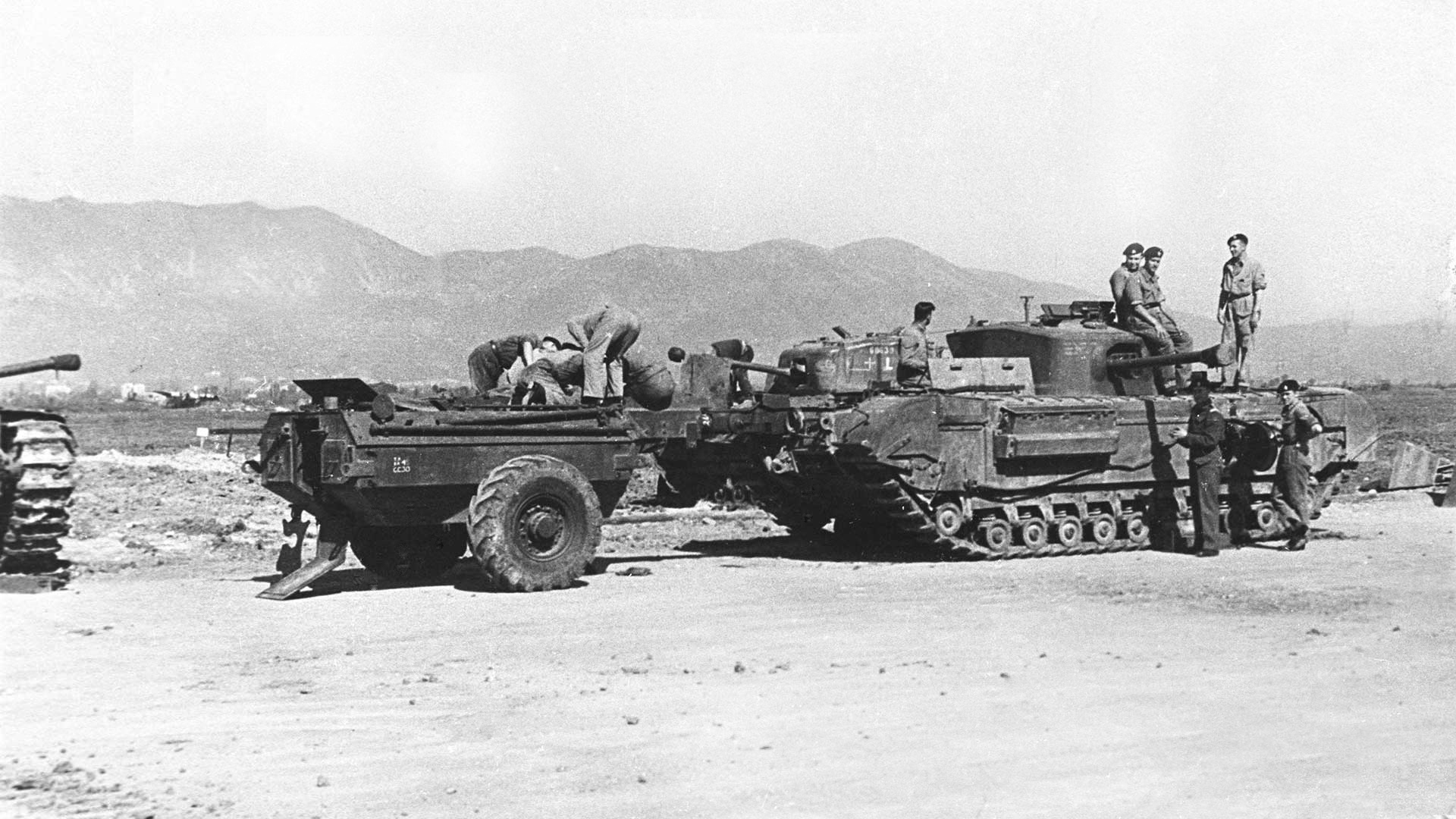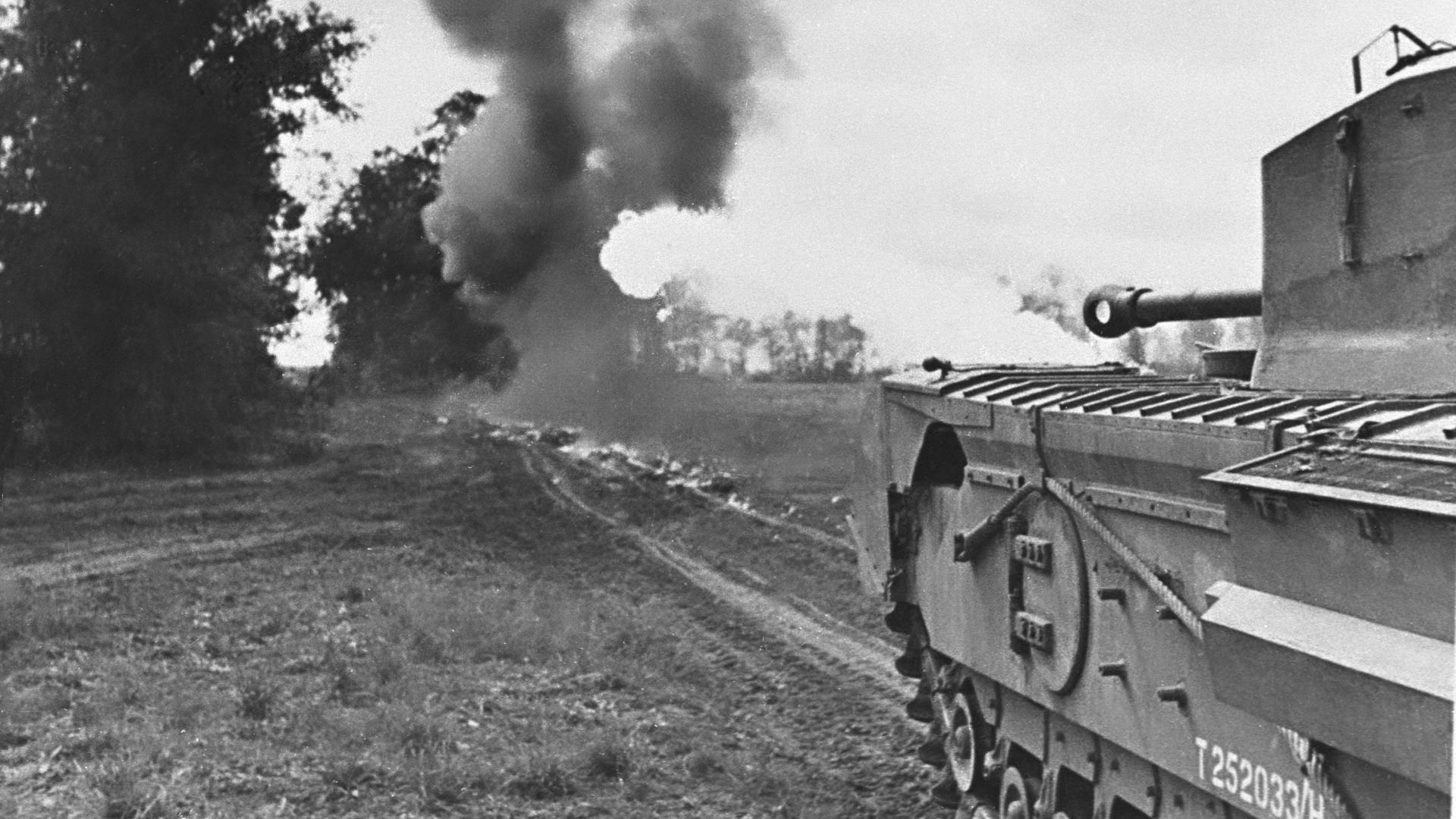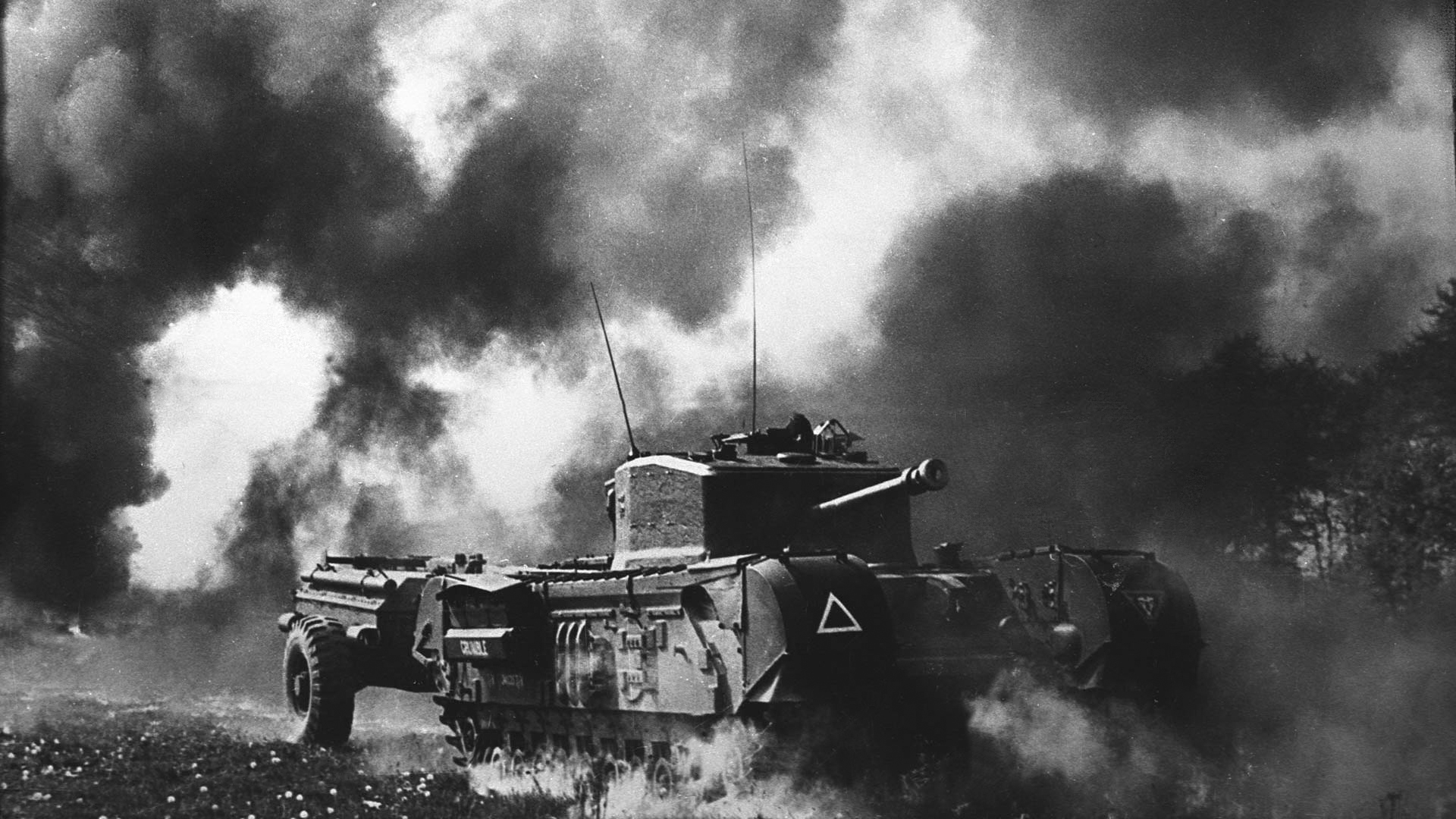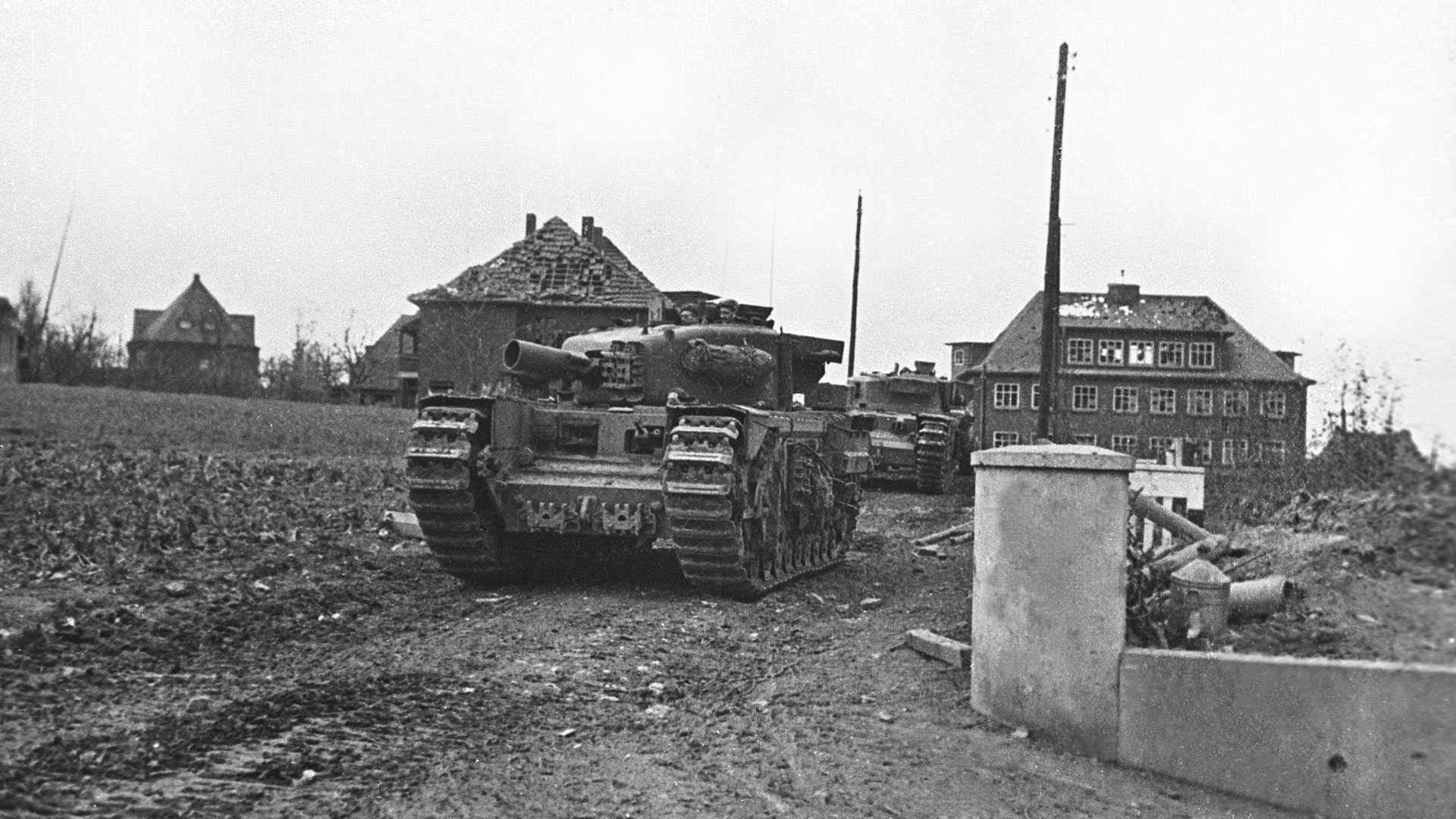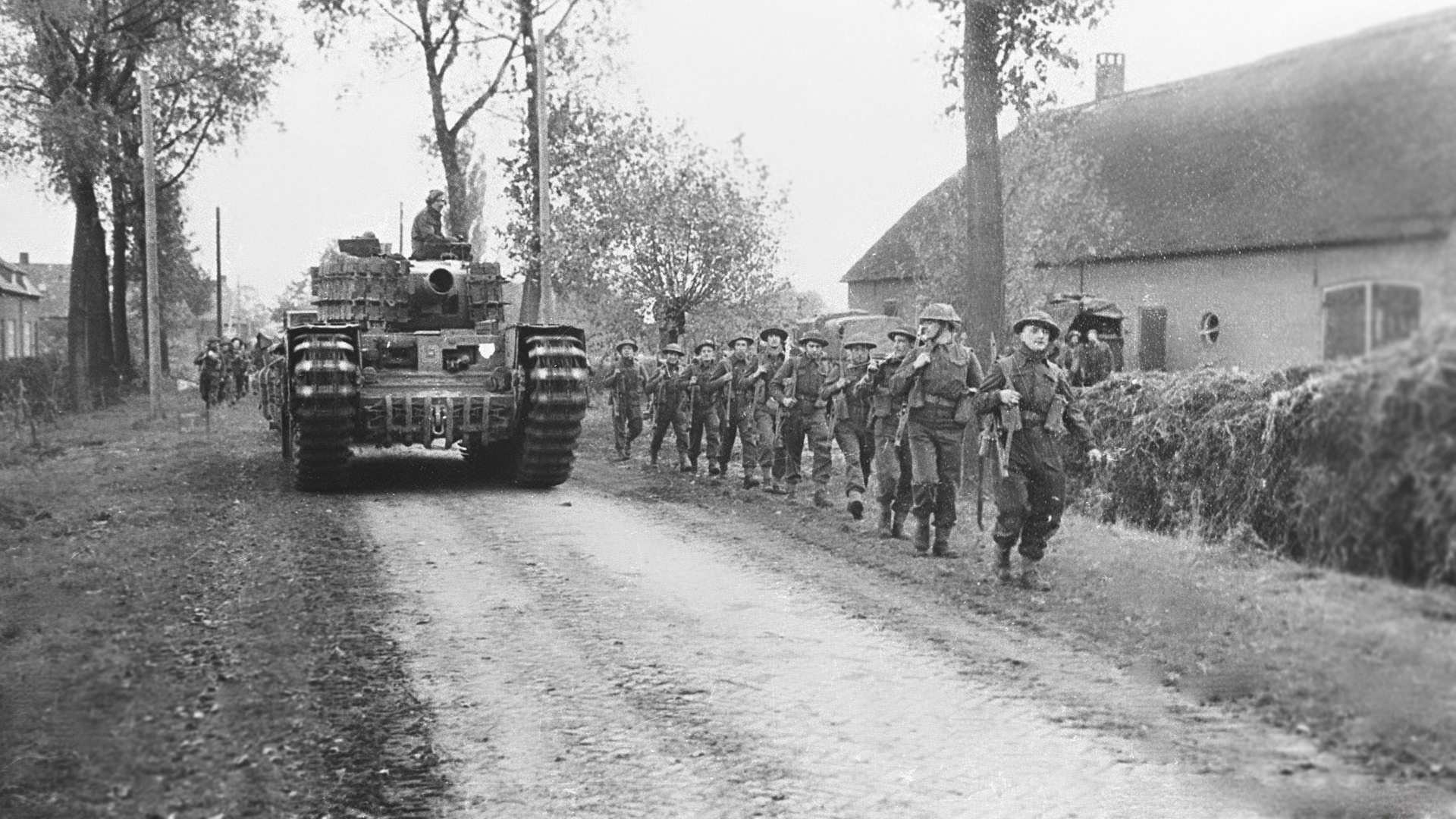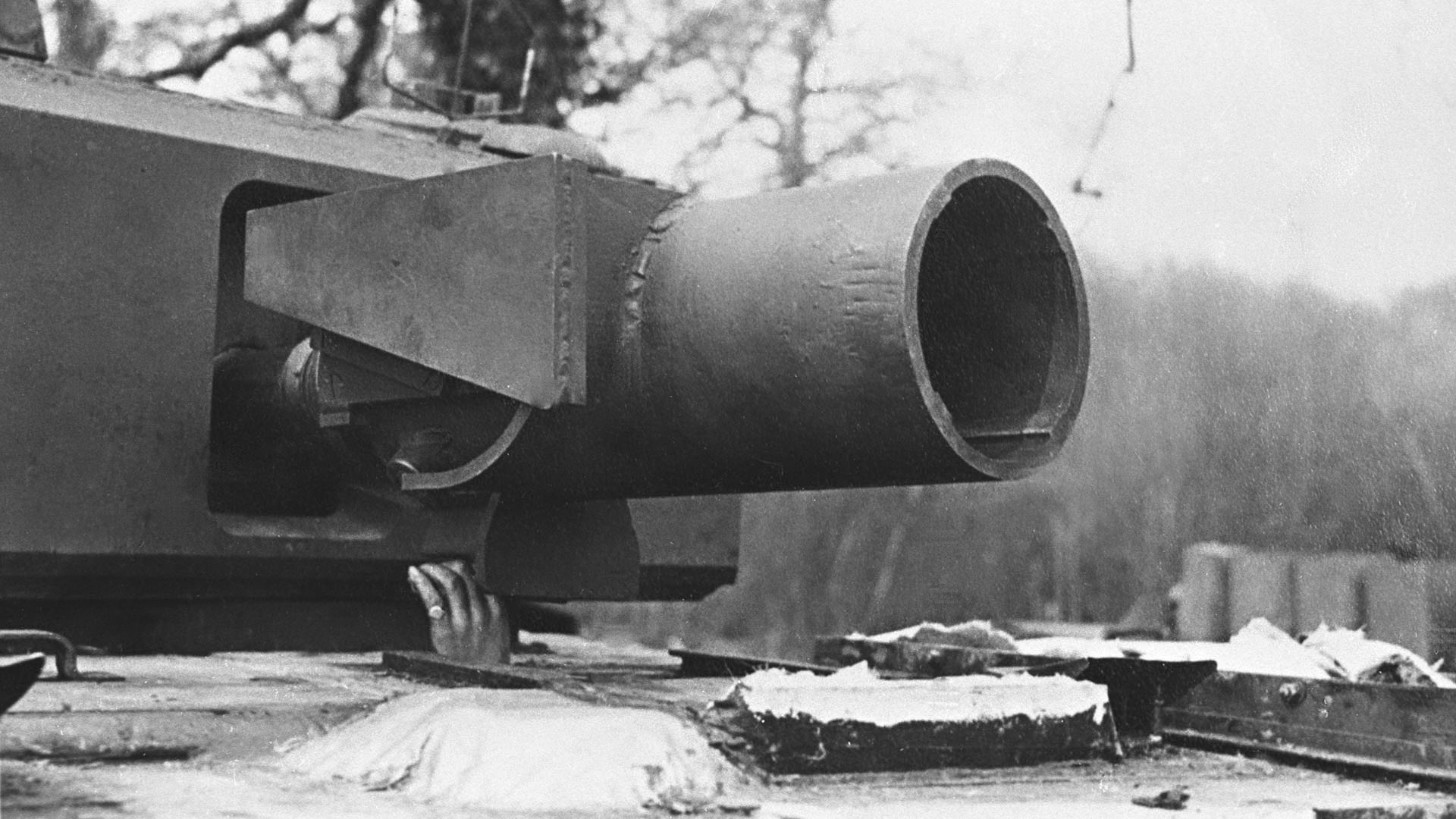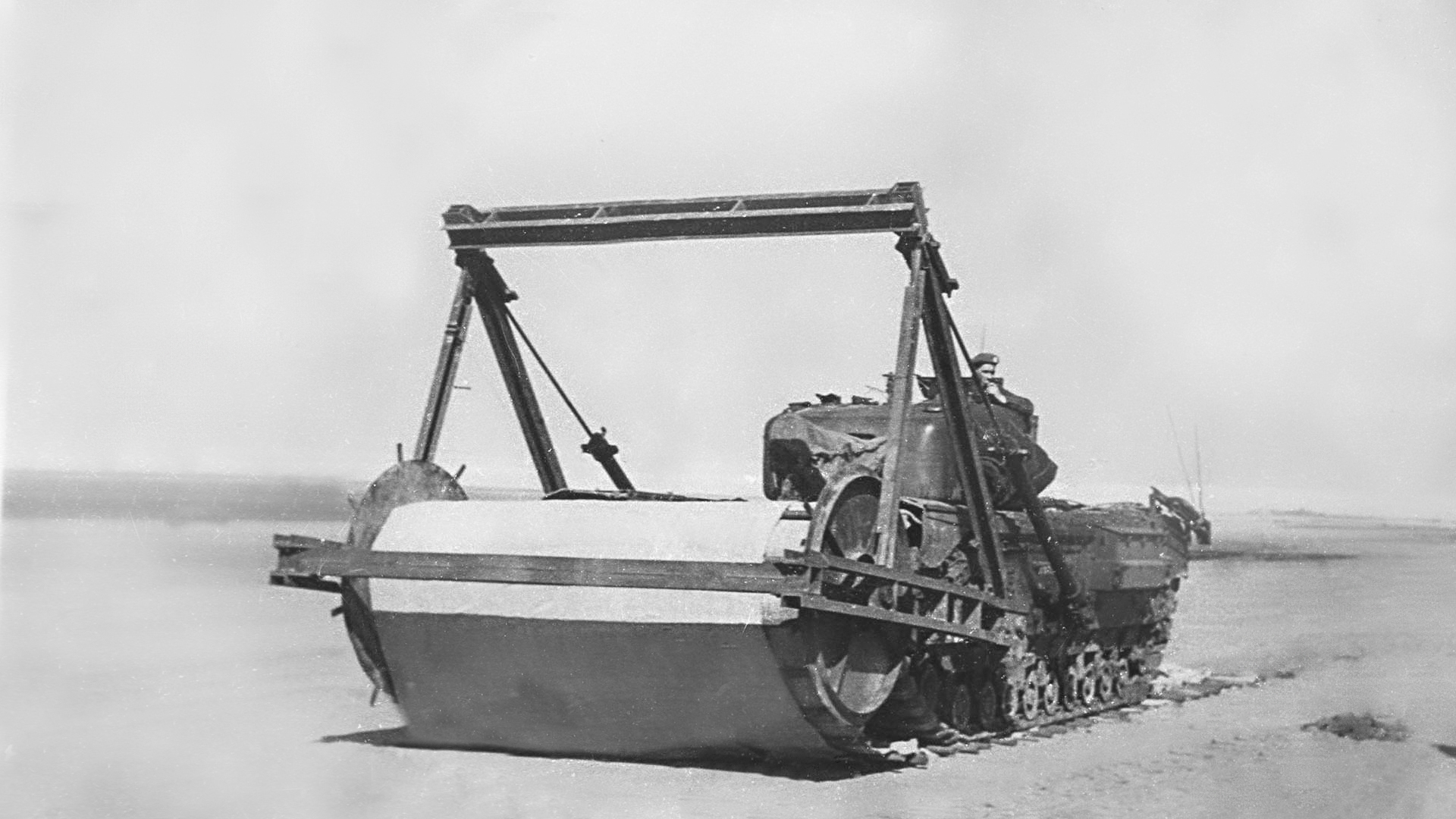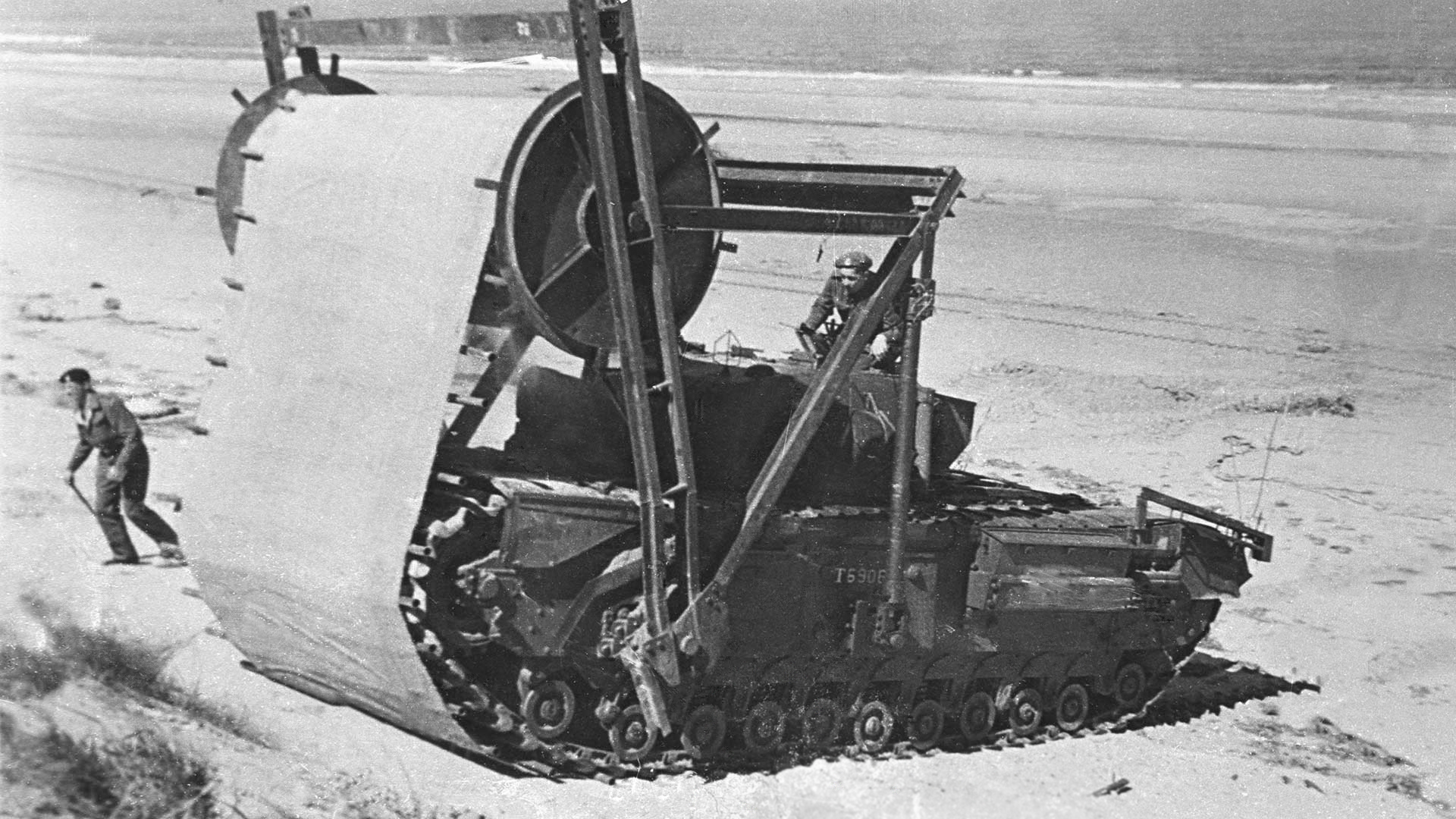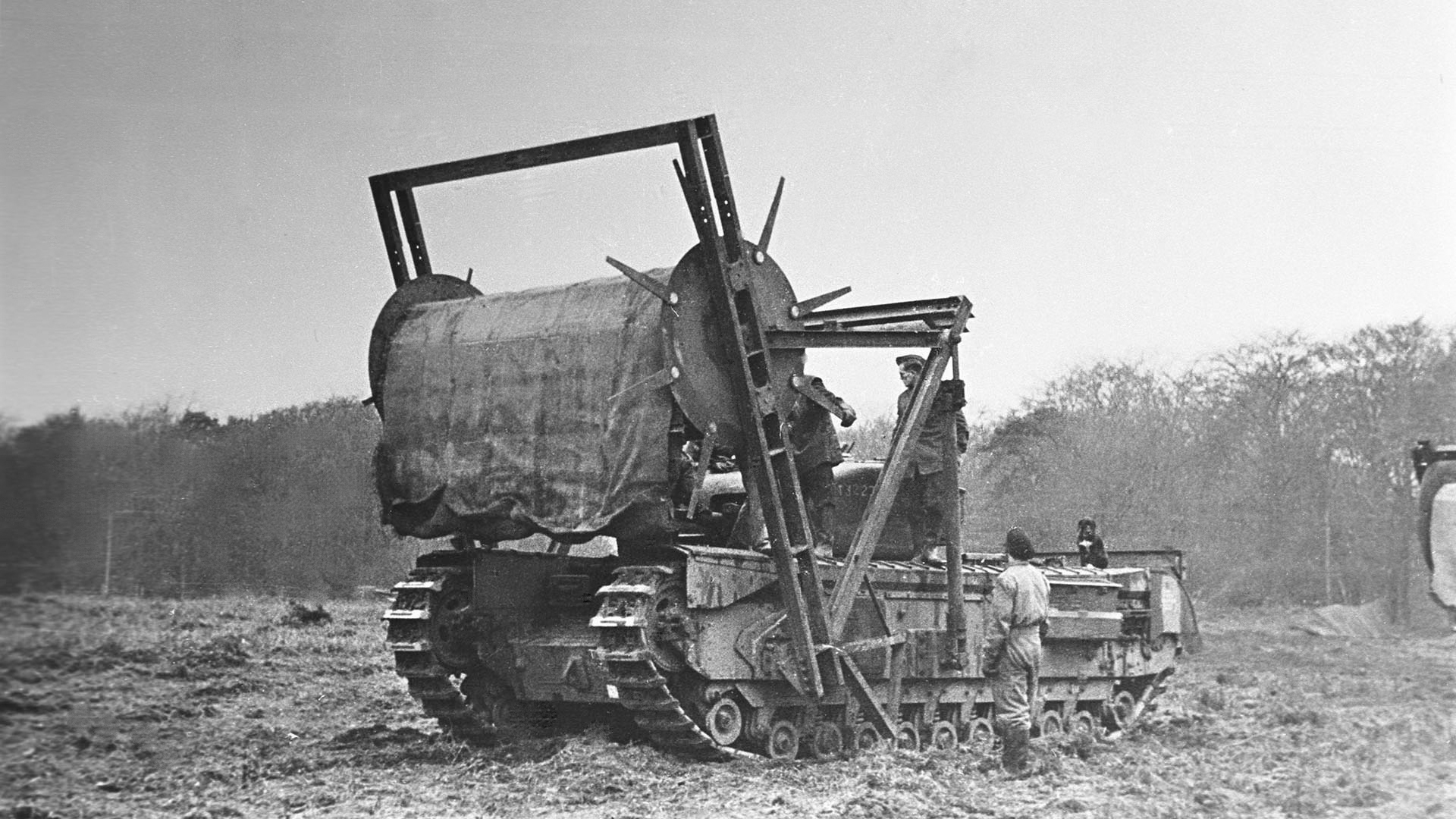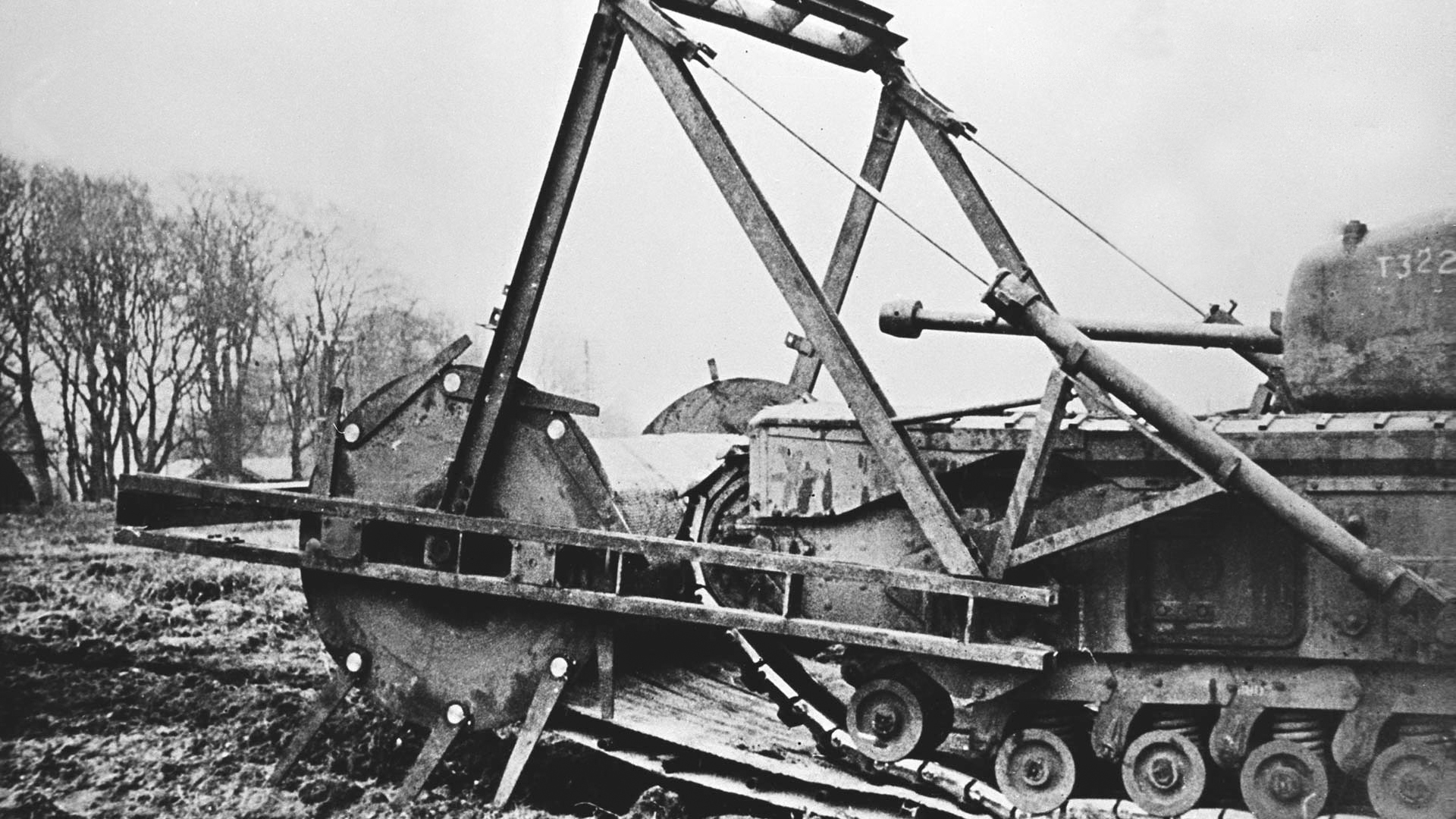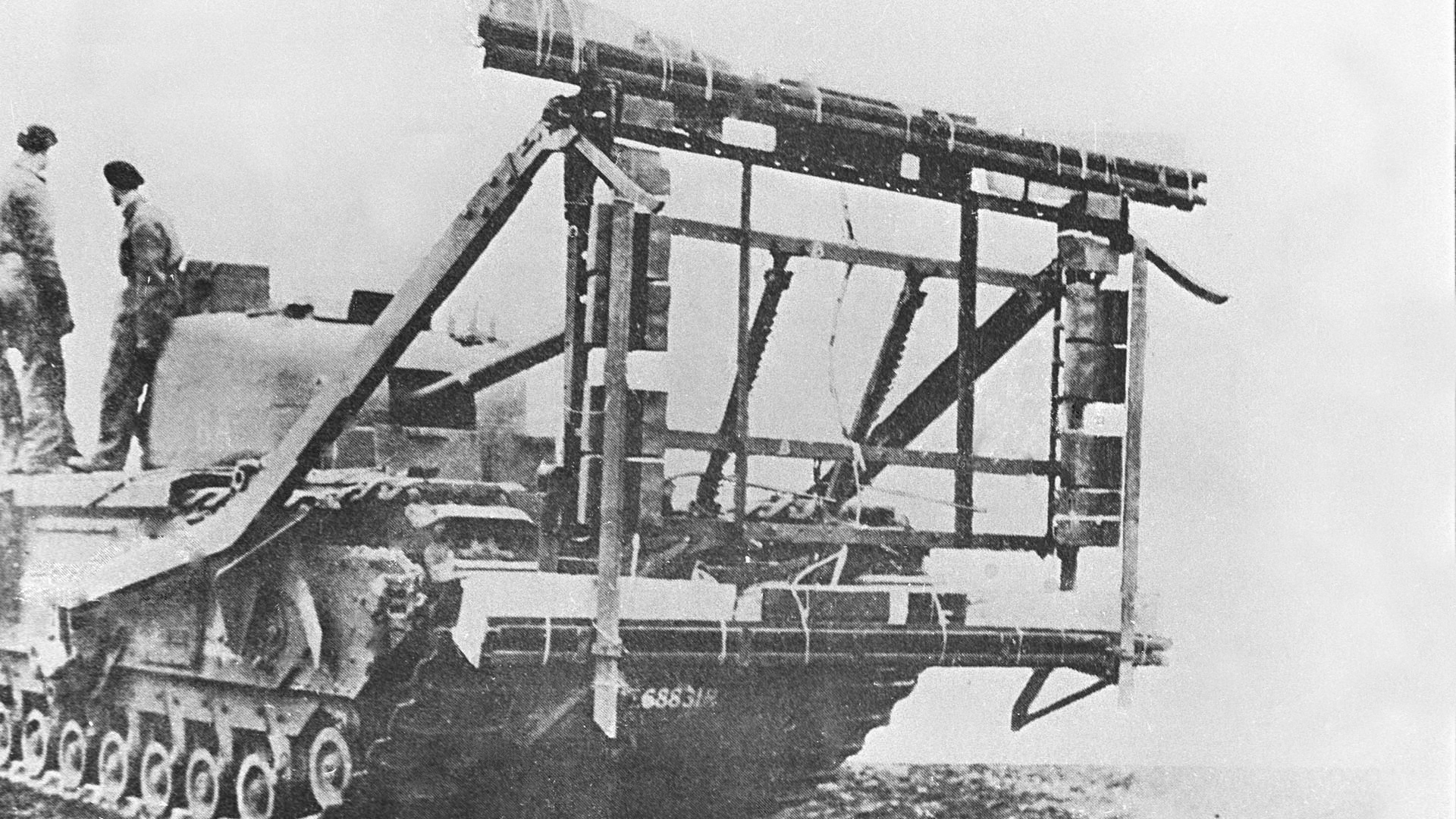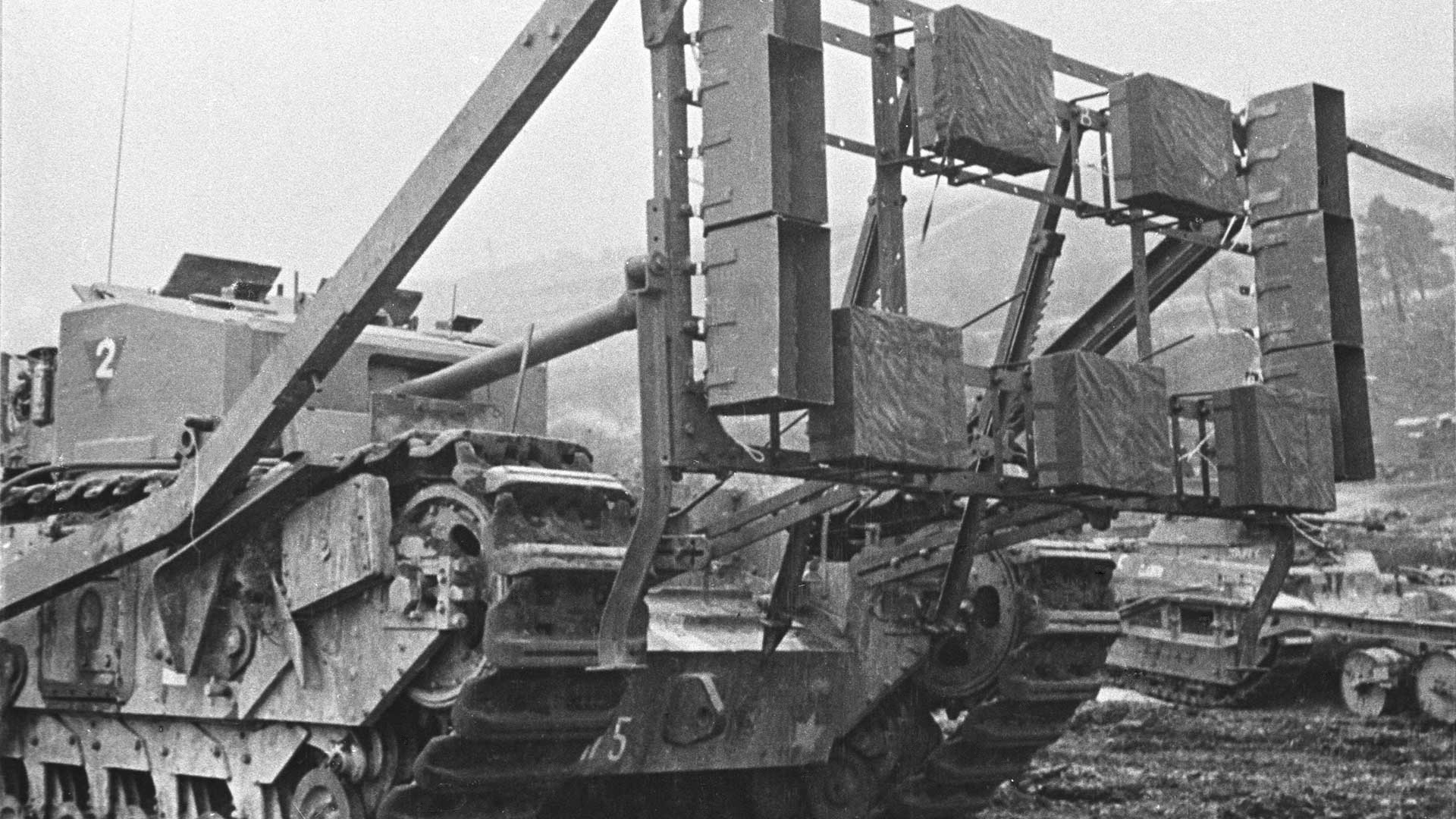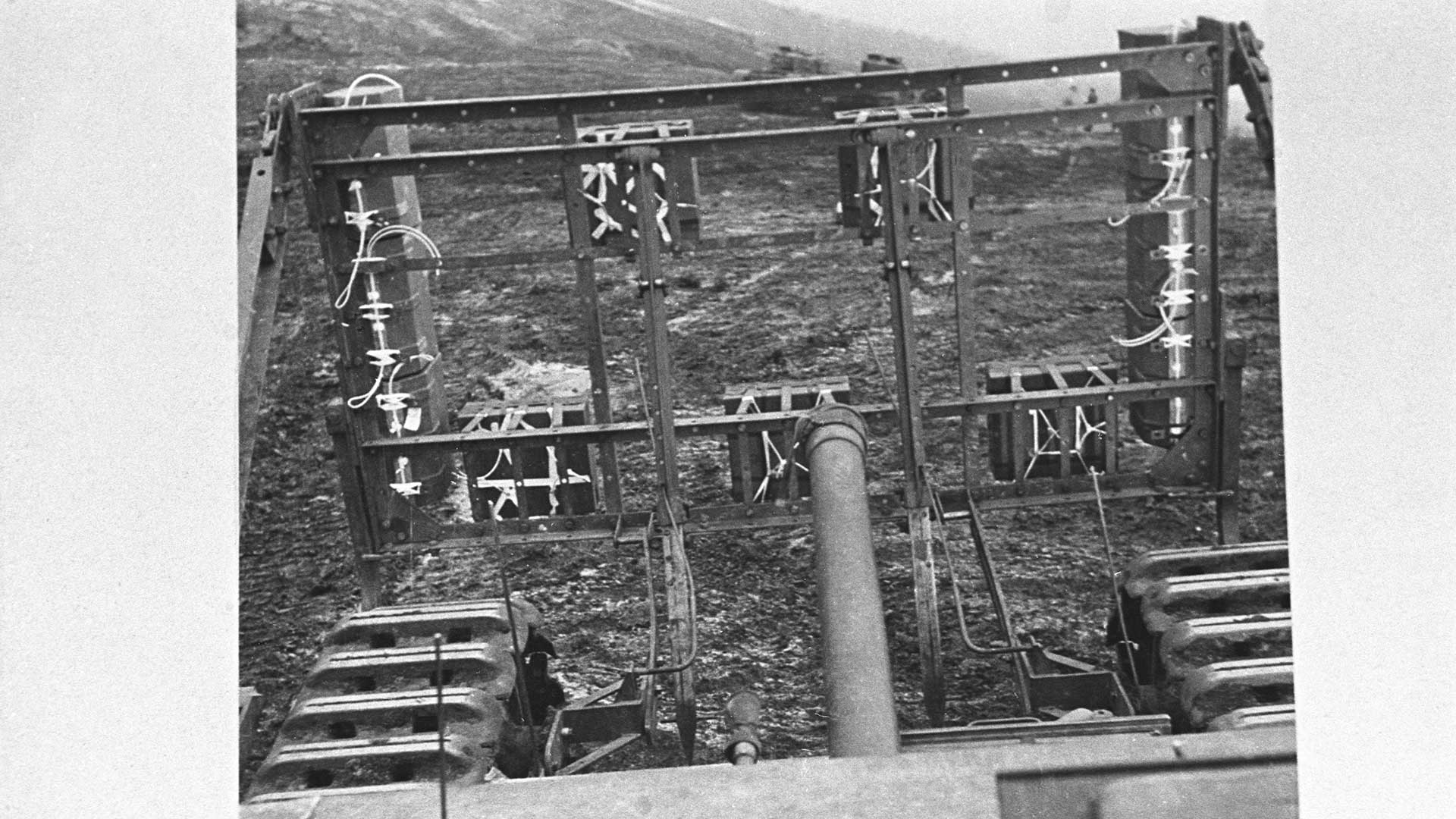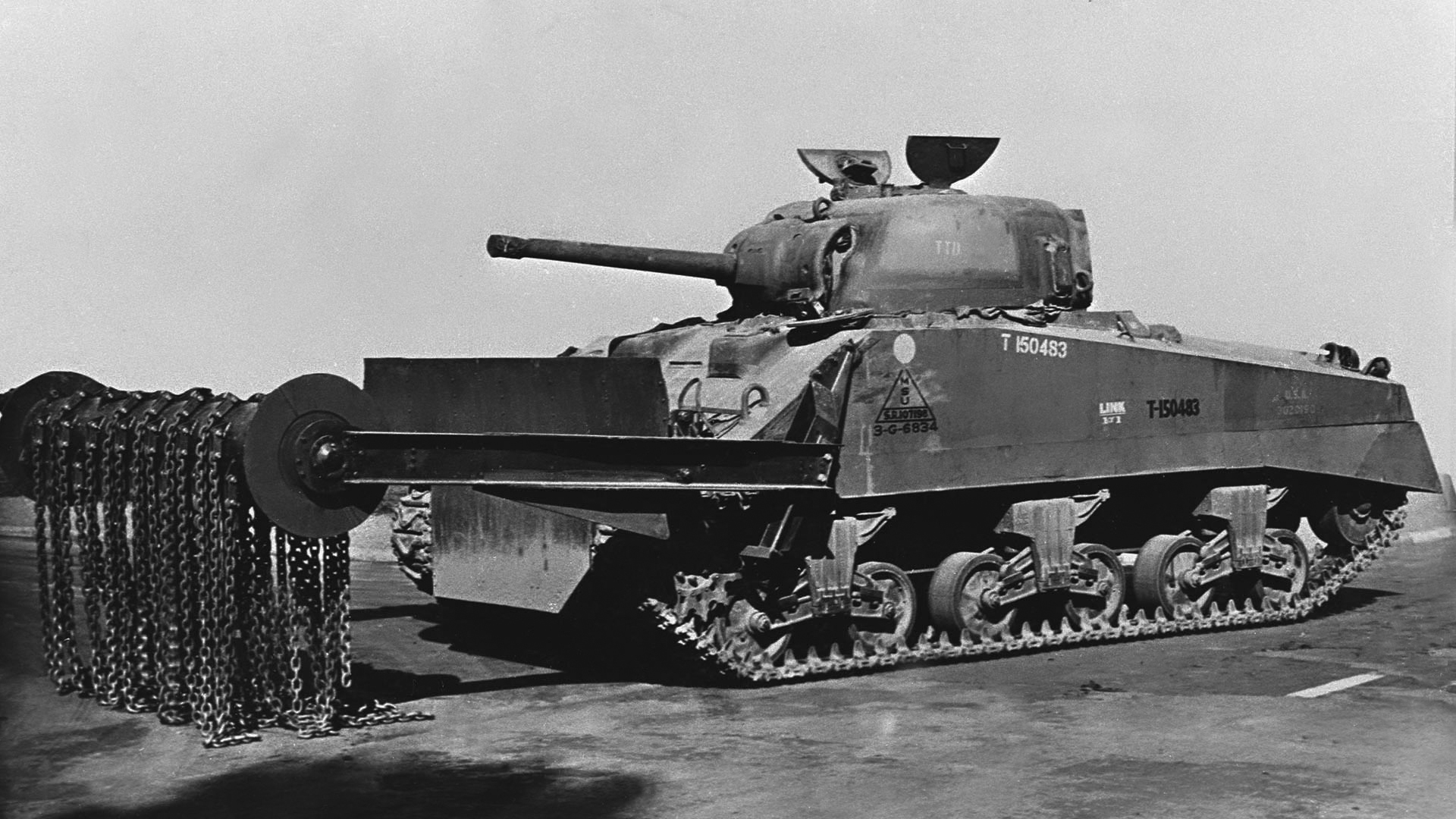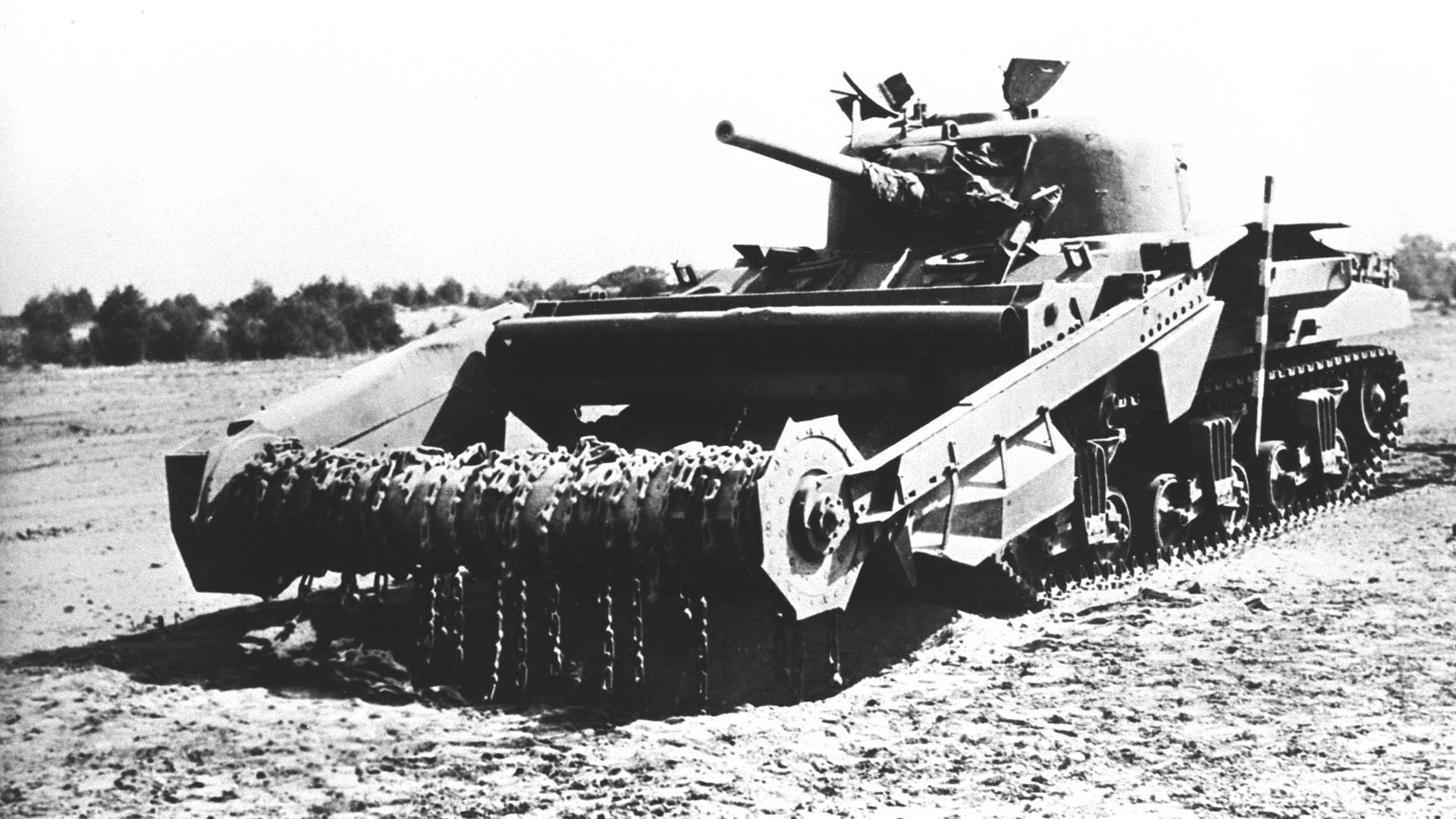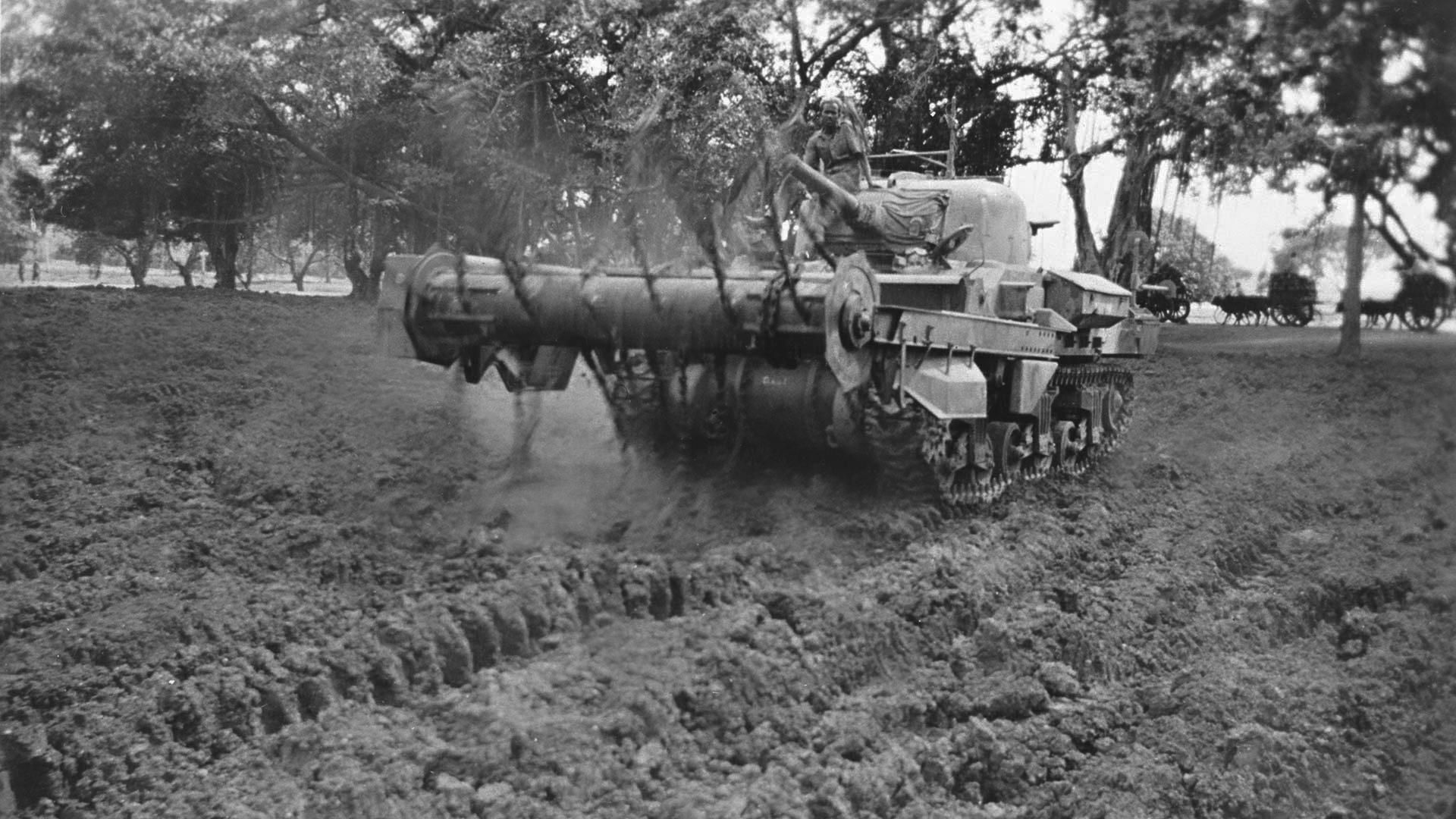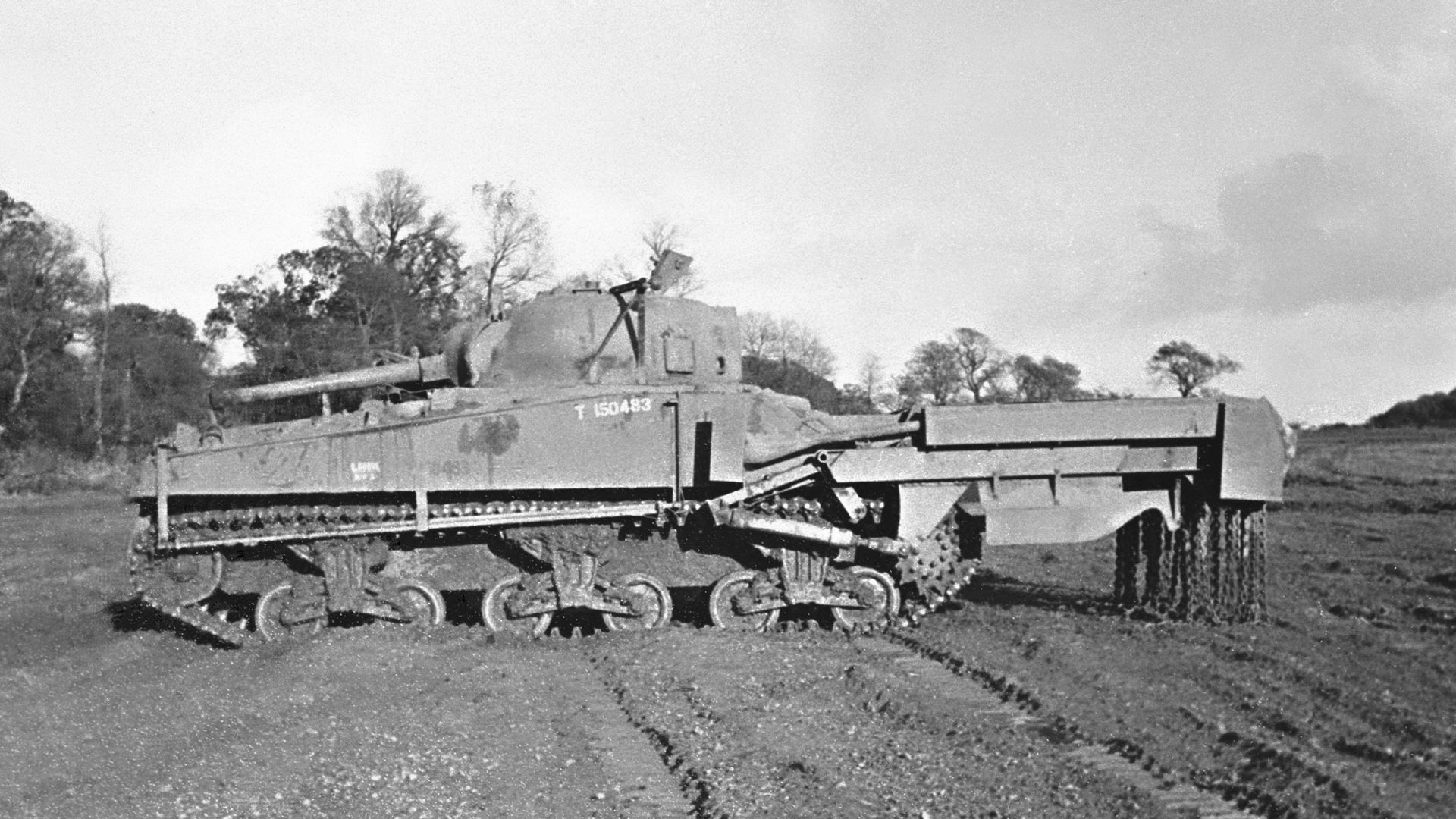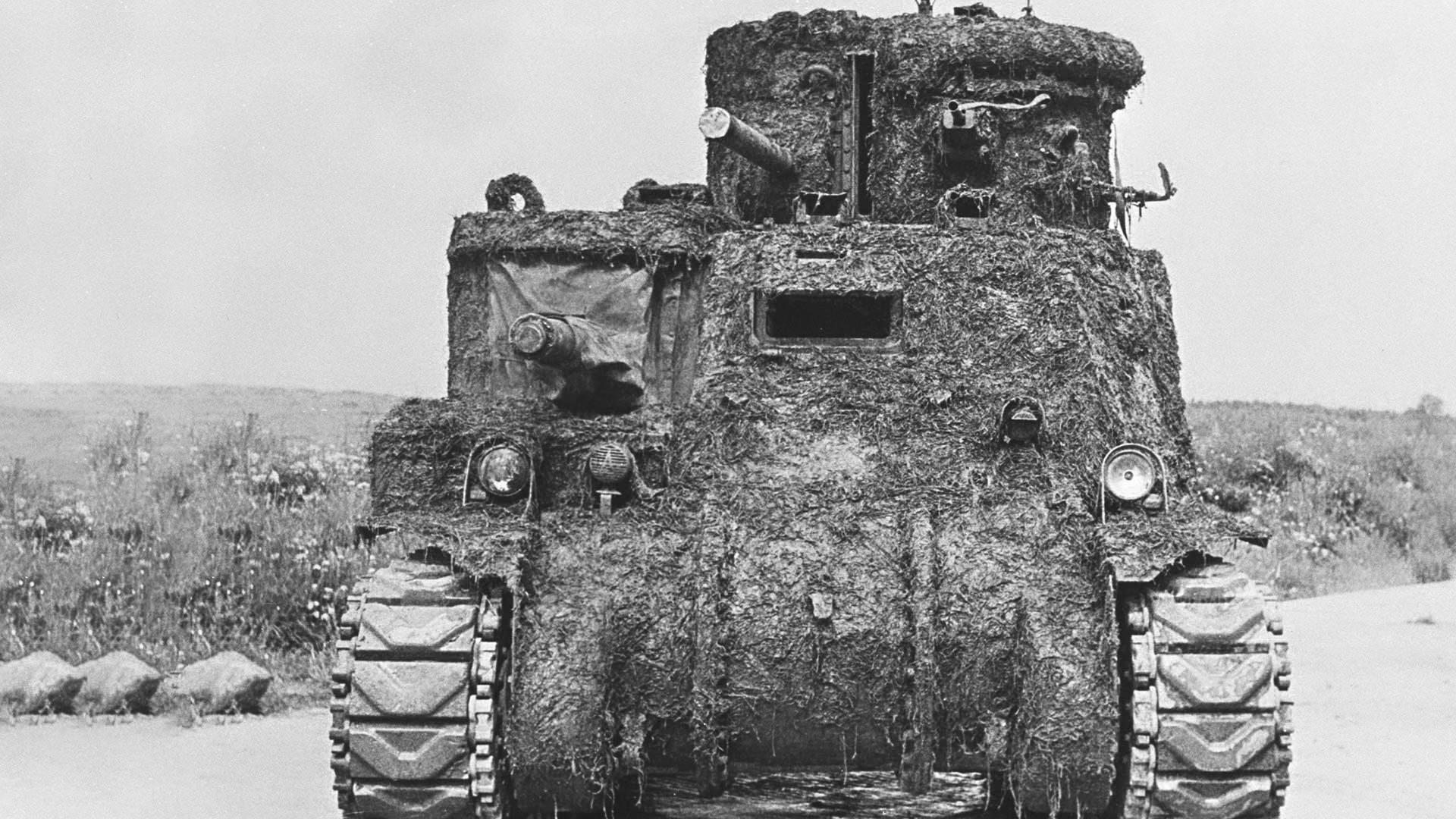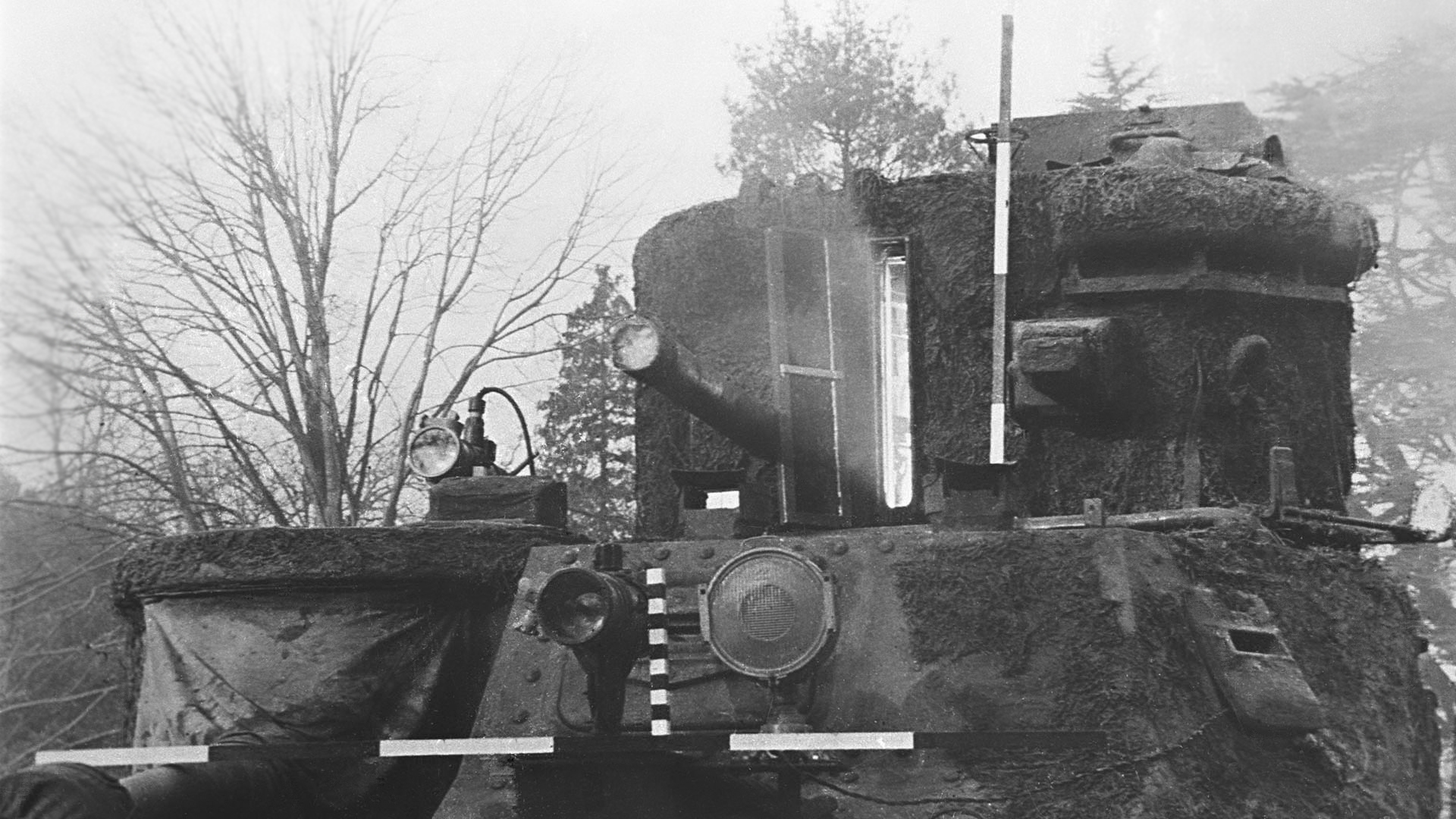Commanders!
Warfare is renowned for driving rapid innovation, growth, and technological advancements.
British Major General Percy Hobart's "Funnies" exemplify this phenomenon. These remarkable vehicles under Hobart's command were deployed from Allied landing ships with specialized equipment to support the successful D-Day invasion.
If you're unfamiliar with these unusual vehicles, prepare to be fascinated as we explore what made these unique vehicle adaptations so impactful on the beaches of Normandy and beyond.
Bravery and Deception Changed the Course of WWII

![]() German Units |
German Units |  U.S. 101st Airborne |
U.S. 101st Airborne |  British 6th Airborne |
British 6th Airborne |  U.S. 82nd Airborne
U.S. 82nd Airborne
On June 6, 1944, the Allied forces launched Operation Overlord, the largest amphibious assault in military history, in Normandy, France. Despite challenging weather conditions and entrenched enemies, the troops landed, fought bravely, and secured five key beaches. The plan was successful, achieving the main objective of establishing a foothold in France and creating a second front against the Axis forces. Eleven months after the invasion, Germany unconditionally surrendered, and World War II in Europe came to an end.
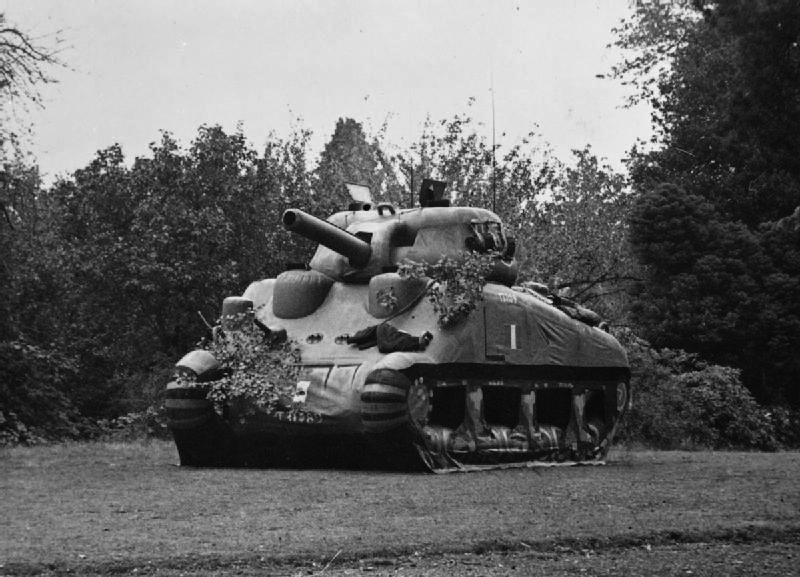 Inflatable "Ghost Army" Tank
Inflatable "Ghost Army" Tank In the planning stages since 1942, Overlord was one of the war's best-kept secrets. The Germans knew an invasion would inevitably happen. The Allies created the impression that the landing would occur at Calais (approximately 200 miles northeast of Normandy) by deploying a "Ghost Army" to deceive German intelligence. Dubbed Operation Fortitude, inflatable tanks, landing craft, fake buildings, and other items were positioned near the coast to give enemies the impression of landing force preparations.
A then-sidelined Gen. George S. Patton also played a vital role in the misdirection campaigns ahead of D-Day. Temporarily removed from command following an infamous soldier-slapping incident, Patton frequently visited—and was deliberately spotted in—the area and was assumed to be the commander of this Ghost Army. German intelligence also refused to believe a commander of Patton's talent would be benched for hitting a soldier, much less not play a key role in the invasion.
These were just some of many successful deceptive campaigns that misdirected the Axis powers and contributed to the success of Overlord.
Hobart's Funnies were No Laughing Matter
 Major-General Sir Percy Cleghorn Stanley Hobart
Major-General Sir Percy Cleghorn Stanley Hobart Normandy wasn't the first Allied amphibious assault on the German-held French north coastline, however. In August 1942, the Dieppe Raid (Operation Jubilee) ended with high casualties after forces temporarily took the port for approximately six hours. Located east of what were to become the D-Day landing zones, the operation was a test run for an invasion of Europe. Allied commanders learned valuable lessons—primarily, invading tanks needed modification for such an assault, as most mechanized vehicles were destroyed and captured.
Enter Major General Percy Hobart, a military engineer commanding the British 79th Armoured Division in WWII. The team around Percy devised devised a series of specialist modifications to Allied tanks, which were then dubbed "Funnies," to overcome coastal fortifications. Churchills, for instance, were fitted with mortars and giant metal walkways that could form a mobile ramp or bridge, while Shermans were equipped with a spinning flail to detonate mines and shred barbed wire. These inventive adaptations were pivotal in breaching the German defenses in Normandy, contributing significantly to the success of the D-Day landings and the broader Allied war effort.
An Unconventional Arsenal
Let’s shine a spotlight on these ingenious engineering marvels, which demonstrated innovative thinking and open-mindedness during one of history’s most pivotal moments. We asked The Tank Museum in Bovington to dive into their archives and retrieve these rare photographs of Hobart’s Funnies in the field.
Flamethrowing Terror. Introducing perhaps the most famous modification of the Churchill Mark IV—the Crocodile flamethrower. An armored towed trailer fuelled the flames that could shoot over a range of 80 meters and proved an efficient means of clearing bunkers, trenches, and other fortifications.
Psychological Weapon. It was actively used by the Allied soldiers and proved a hellish psychological weapon against German troops hunkered in their bunkers. Many reports suggest they surrendered once they saw the fire-breathing Churchill creeping toward them. Sometimes crews would spray a "wet squirt" or "wet shot" of fuel to warn enemies and give them a chance to surrender.
Earn three brand-new Tier VI Premium vehicles with Normandy-inspired 3D styles, including the Churchill Crocodile, as base rewards in Battle Pass XIV: D-Day!
Terrifying HE Mortar. In this AVRE (Assault Vehicle Royal Engineers) variation, the Churchill's main gun was replaced with a 230 mm Petard spigot mortar, capable of firing a 40 lb (18 kg) HE shell over 100 meters. Scarily for the crews, it had to be reloaded externally by opening a hatch and sliding a round into the mortar tube from the hull. Nicknamed the "flying dustbin," it proved successful in destroying concrete bunkers and roadblocks as the Allies advanced.
Variations on Variations. Specialized equipment could be added to these tanks in several "child" variations of the already-adapted AVRE, including the Churchill AVRE Bobbin, which is discussed below.
Path Layer. This Churchill AVRE was adapted to lay reinforced canvas matting down over soft sand and terrain that otherwise could not support the weight of other armored vehicles.
Canvas Road. This variation was equipped with a reel of three-meter wide canvas cloth reinforced with steel poles that could roll a makeshift road over 100 meters.
Bridge Builders
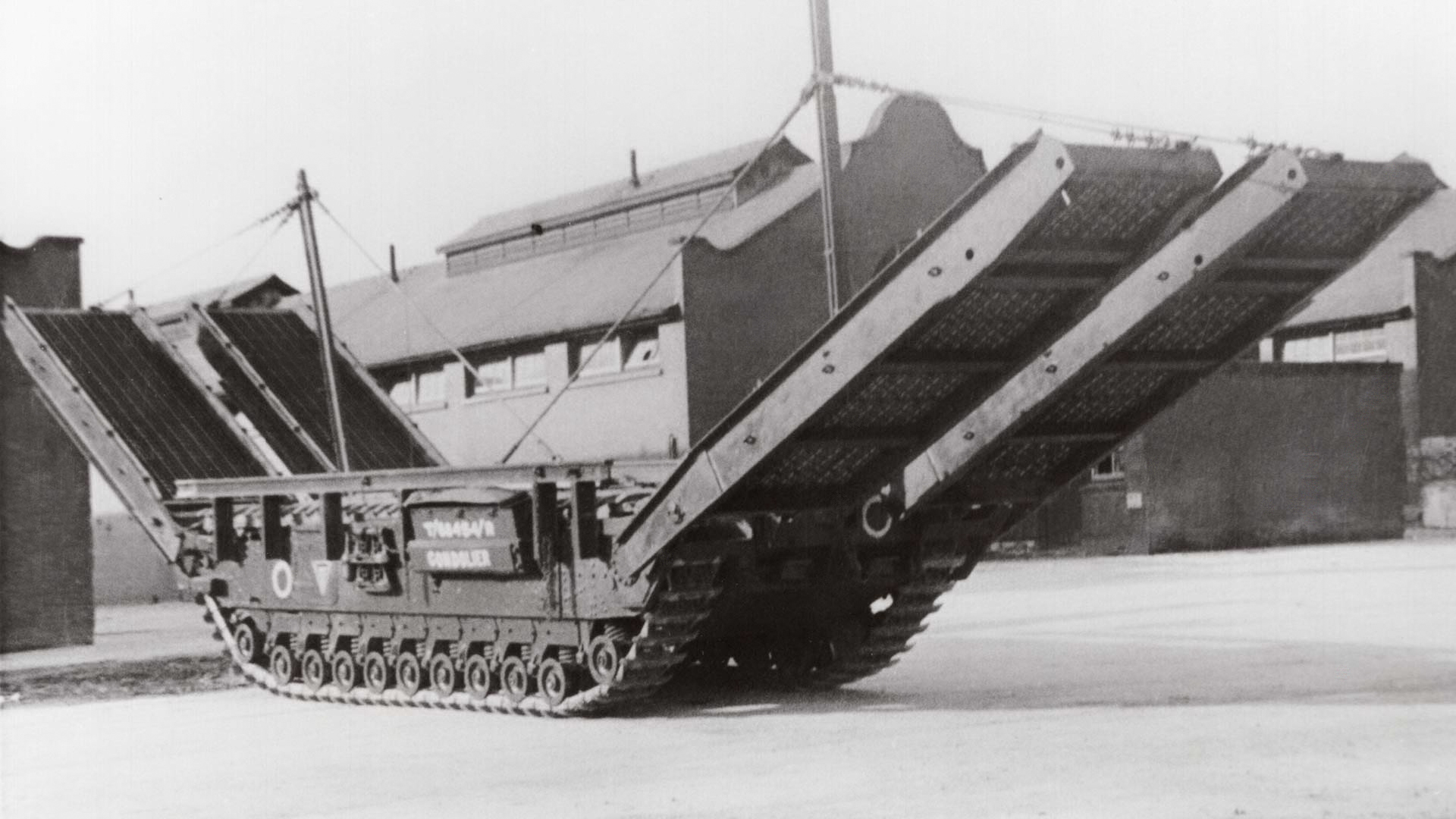 Churchill ARK, Italian pattern (0040-C4)
Churchill ARK, Italian pattern (0040-C4) 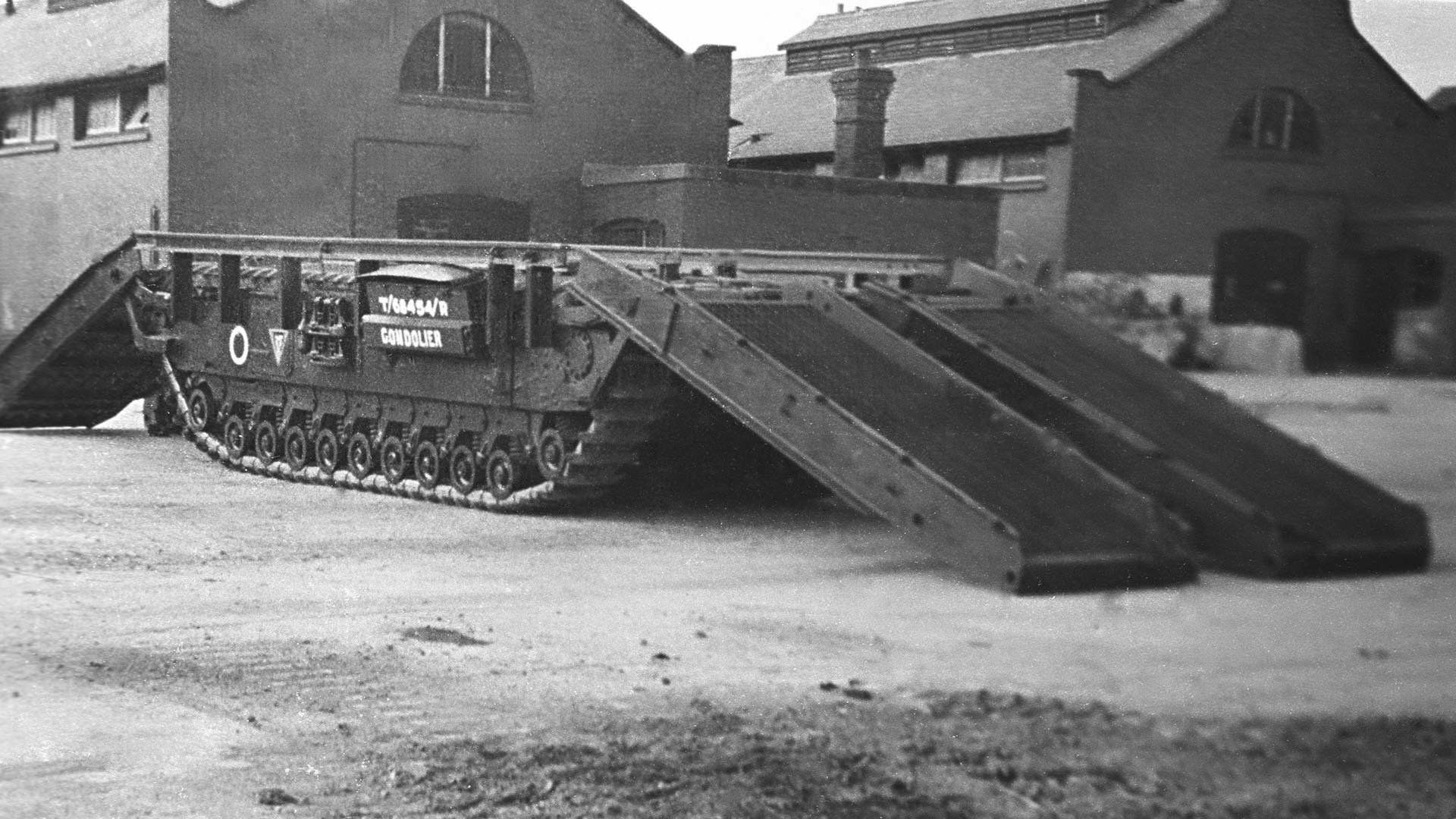 Churchill ARK Mk II, Italian pattern (0183-F1)
Churchill ARK Mk II, Italian pattern (0183-F1) 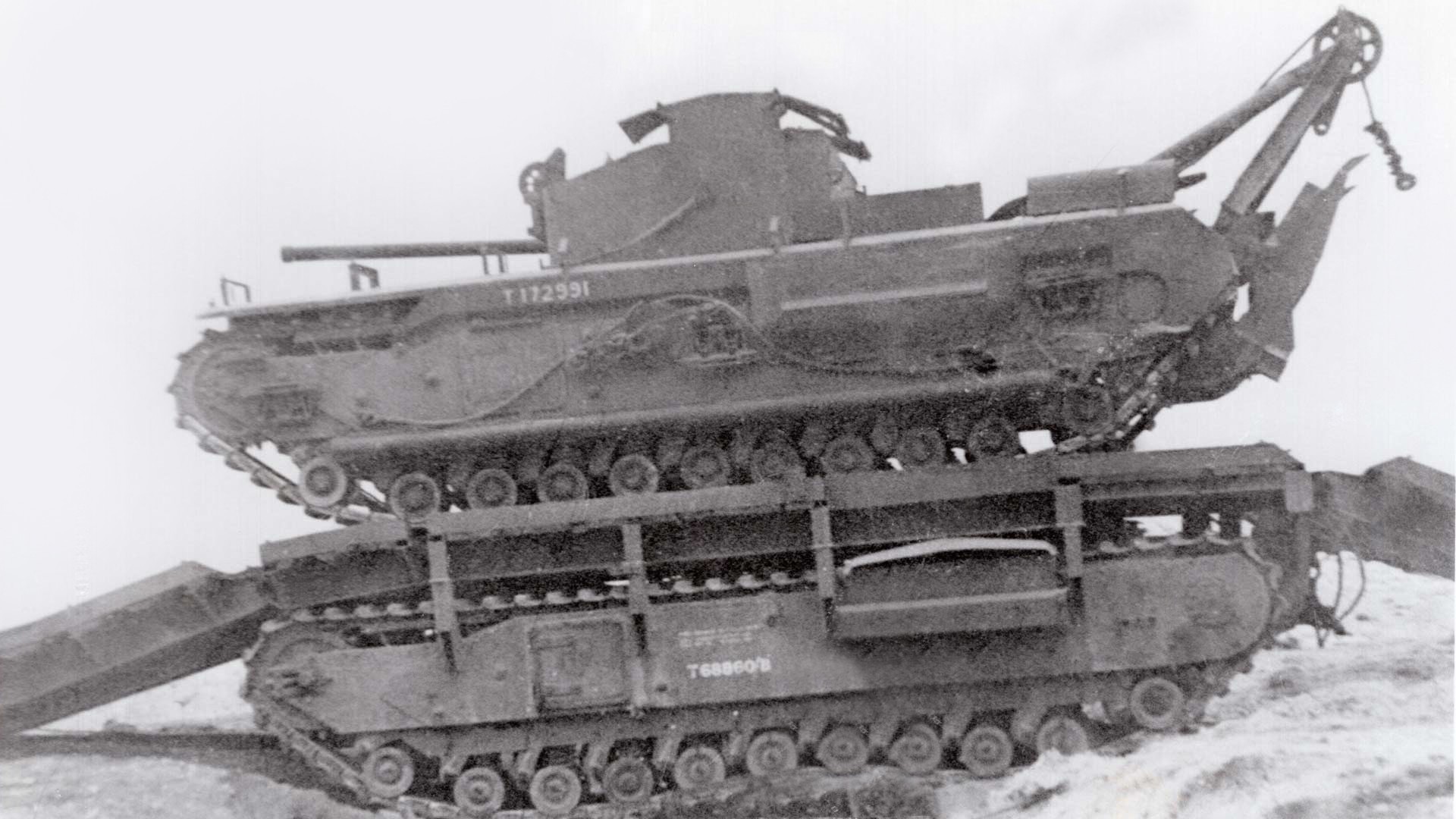 Churchill ARK Mk II, U.K. pattern, with Churchill ARV Mk II on top (0040-B4)
Churchill ARK Mk II, U.K. pattern, with Churchill ARV Mk II on top (0040-B4) 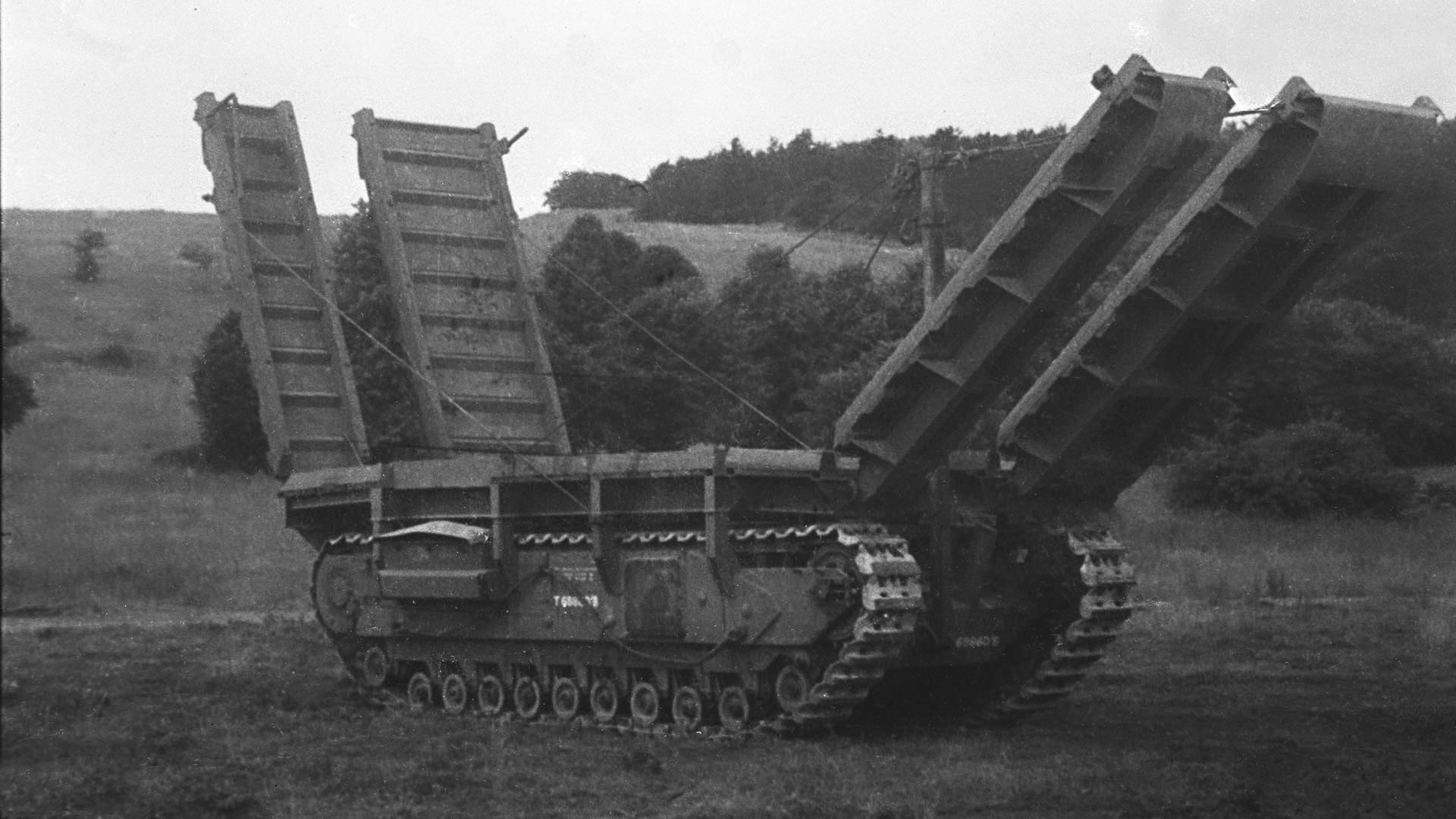 Churchill ARK Mk II, U.K. pattern (0183-H4)
Churchill ARK Mk II, U.K. pattern (0183-H4)
Armoured Ramp Carrier (ARK). A turretless Churchill tank was modified with extendable ramps at either end so other vehicles could scale obstacles, effectively acting as a mobile bridge.
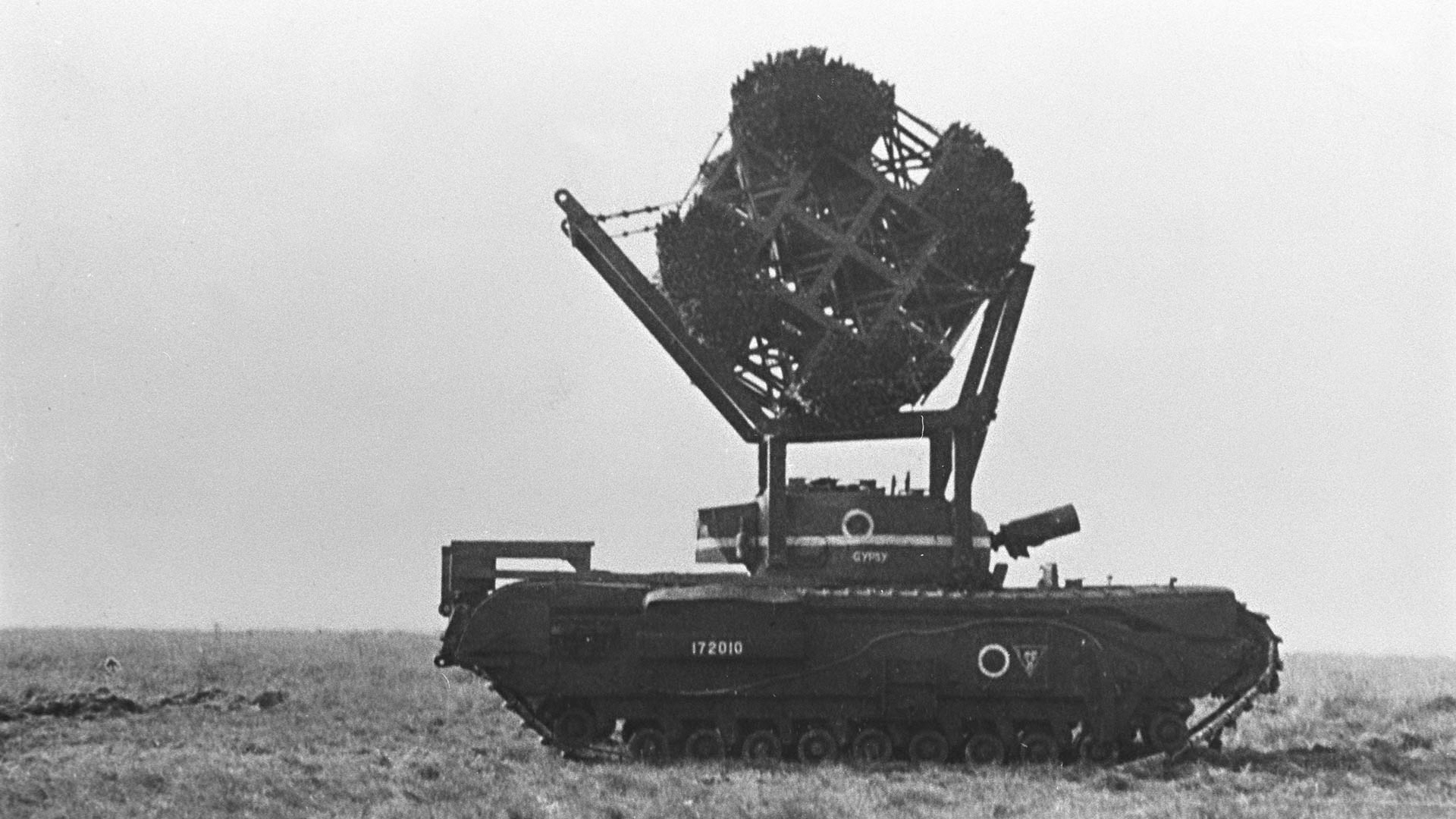 Churchill Mk IV AVRE with Moyens launcher and Dumbell fascine (experimental) (0343-D3)
Churchill Mk IV AVRE with Moyens launcher and Dumbell fascine (experimental) (0343-D3) 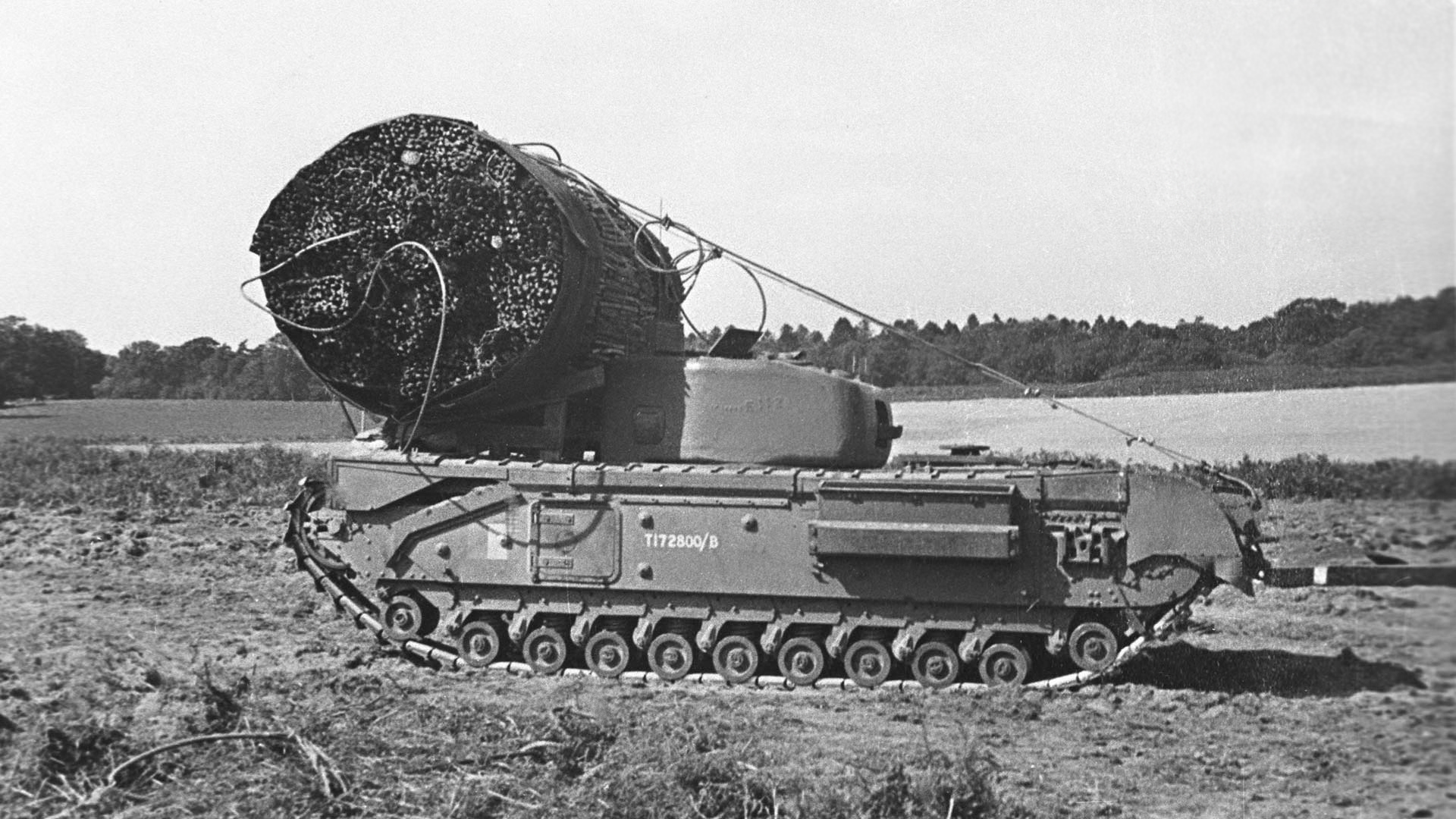 Churchill Mk IV AVRE with fascine (0343-B6)
Churchill Mk IV AVRE with fascine (0343-B6) 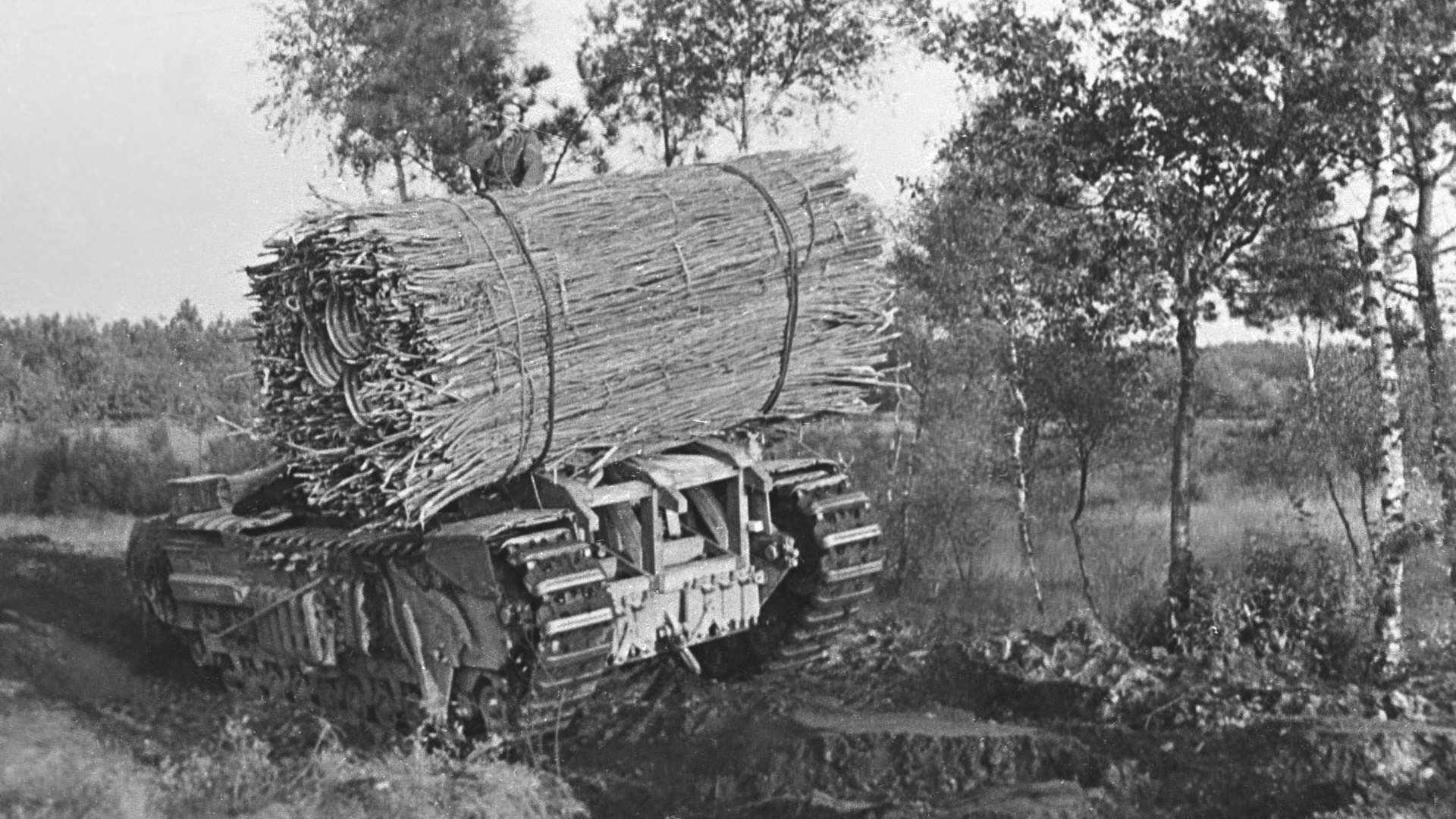 Churchill AVRE carrying fascine (0334-F6)
Churchill AVRE carrying fascine (0334-F6) 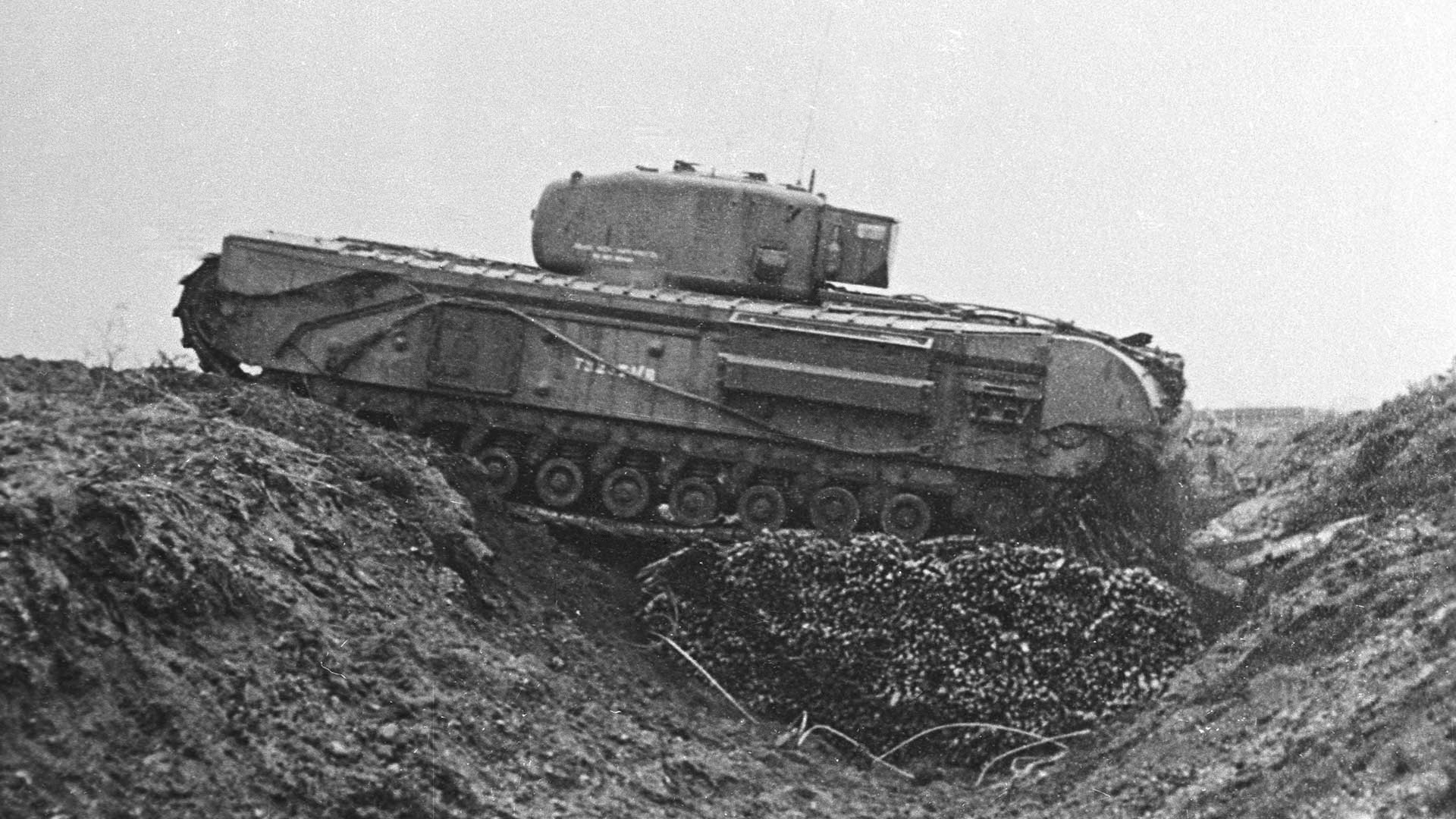 Churchill IV AVRE crossing fascine (0341-F6)
Churchill IV AVRE crossing fascine (0341-F6)
Fascines. Fascines—large bundles of wooden sticks and meshed brushwood—could bridge trenches and gaps in the ground for infantry and vehicles to cross. They were first used during World War I but were brought back nearly 30 years later, ahead of the D-Day invasion.
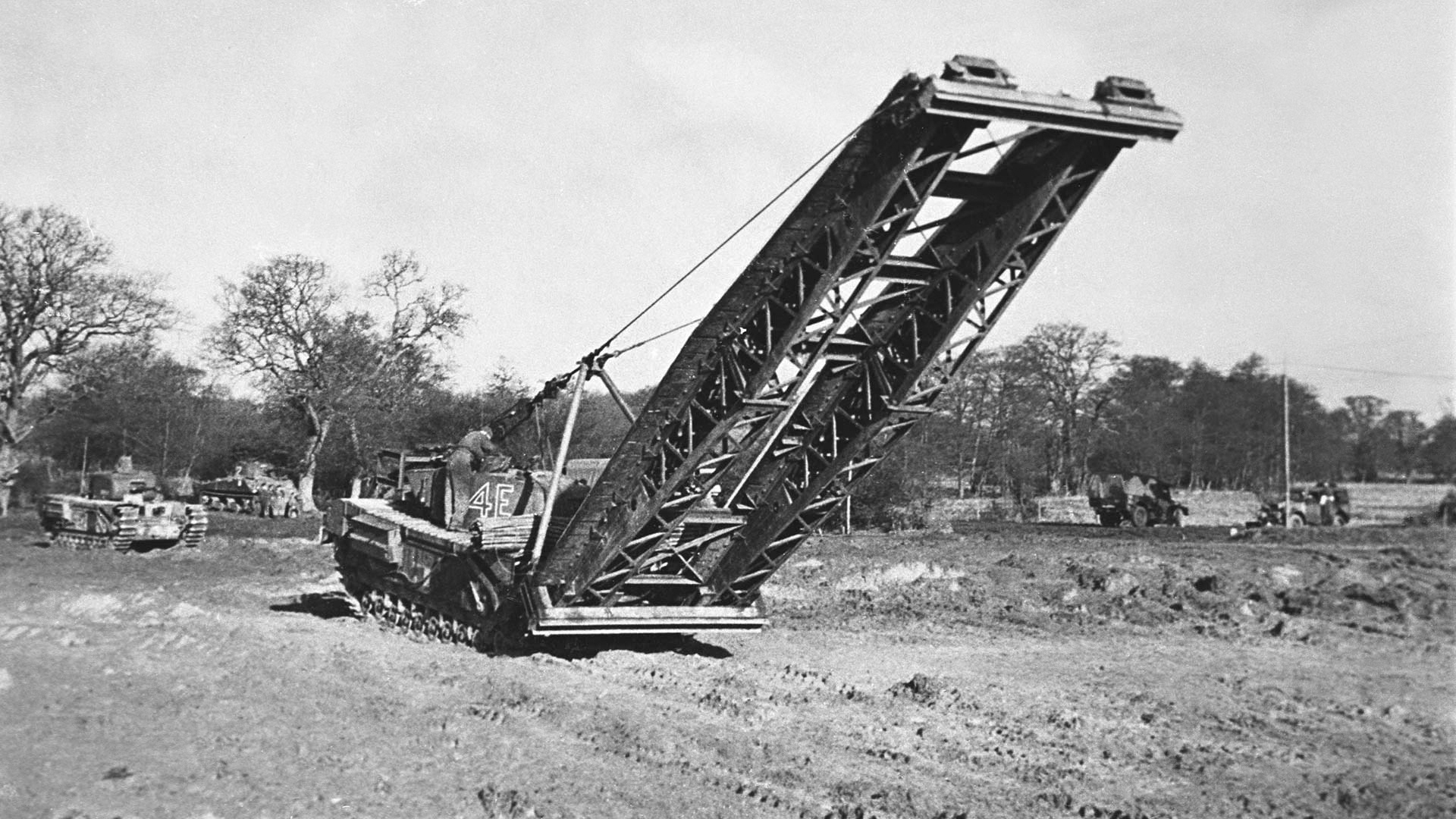 Churchill AVRE with a small box girder bridge (SBG) (0183-E3)
Churchill AVRE with a small box girder bridge (SBG) (0183-E3) 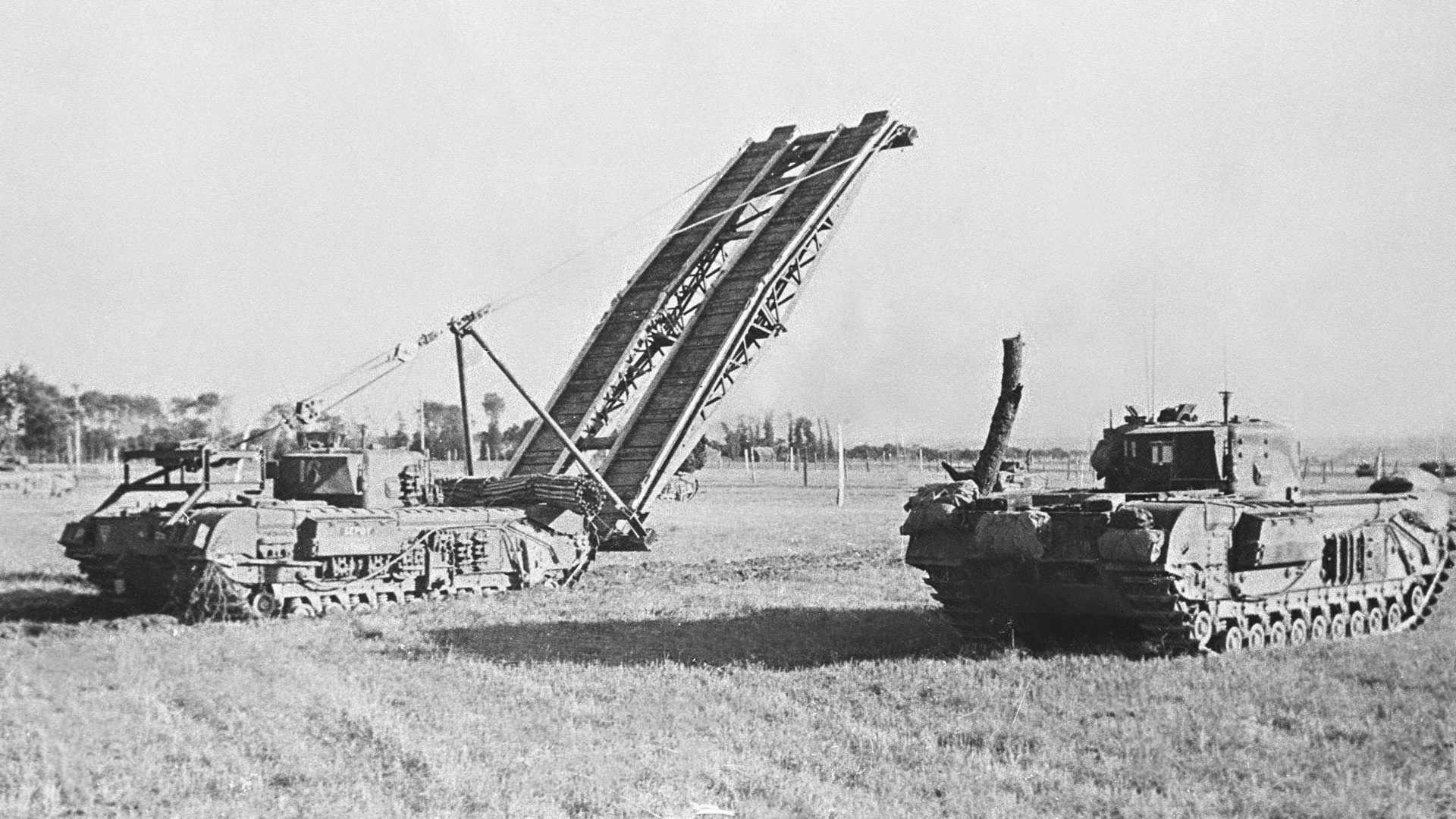 Churchill AVRE with an SBG bridge (0350-C5)
Churchill AVRE with an SBG bridge (0350-C5)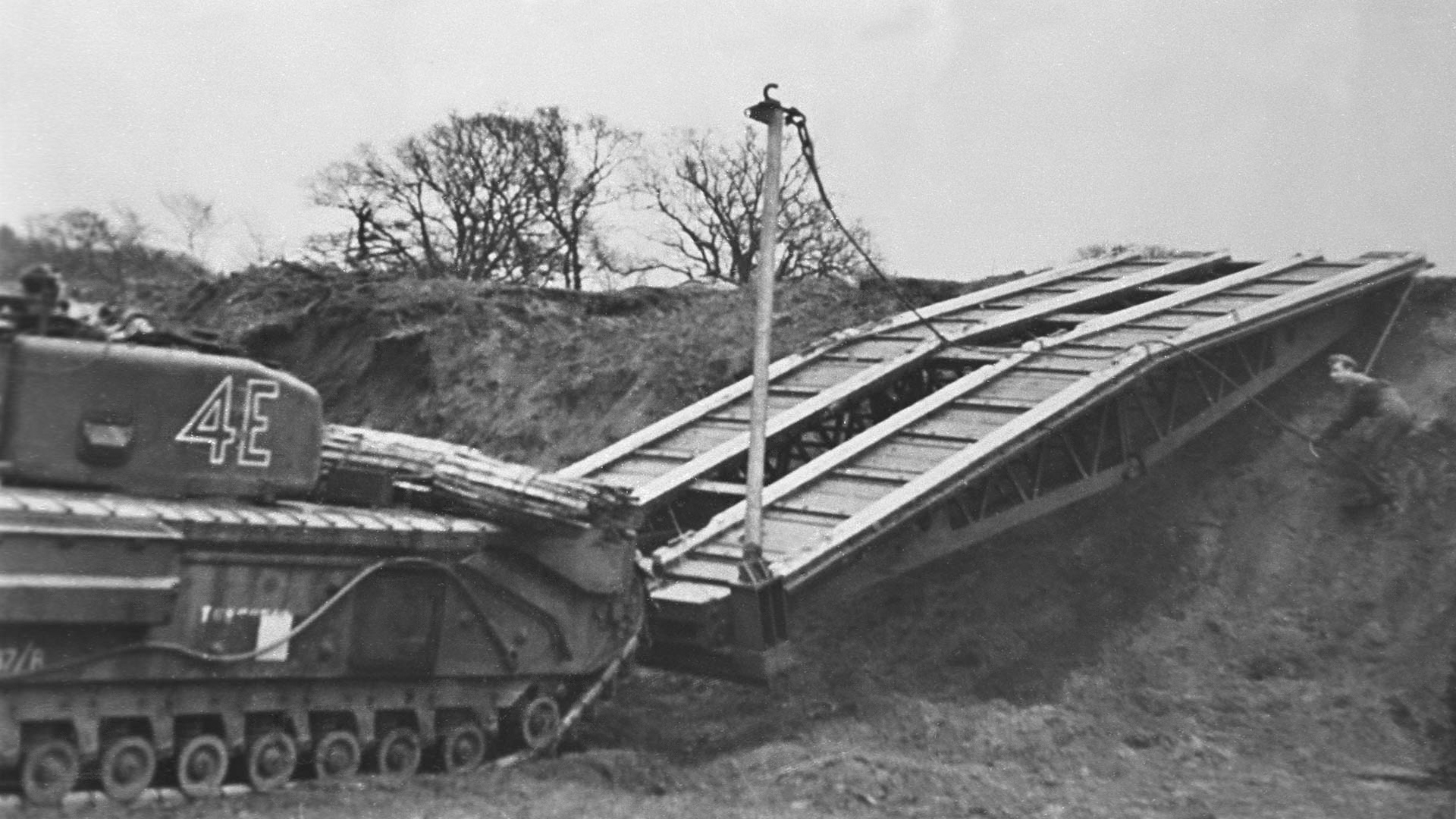 Churchill IV AVRE deploying an SBG bridge (0229-E1)
Churchill IV AVRE deploying an SBG bridge (0229-E1)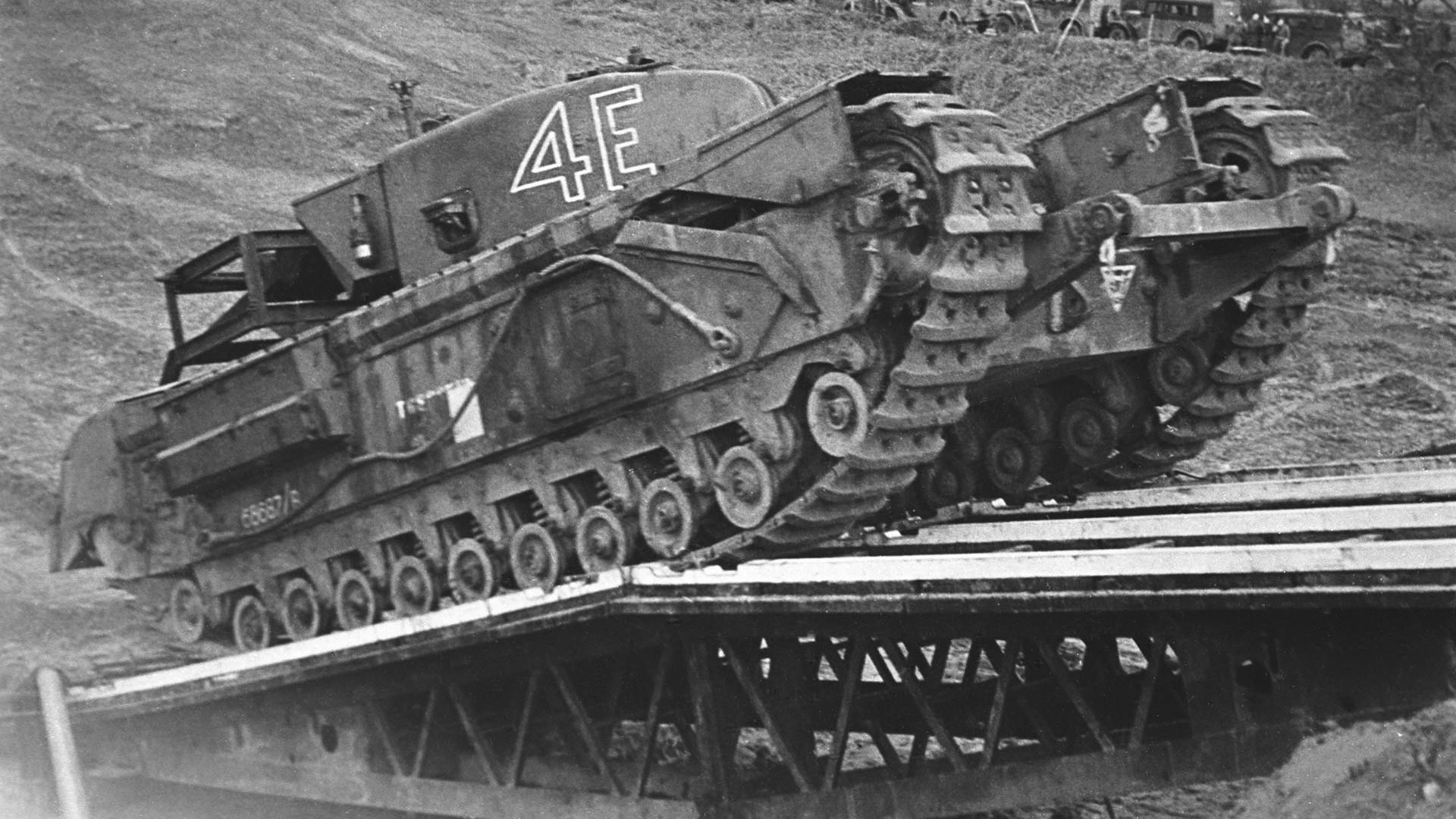 Churchill IV AVRE crossing an SBG bridge (0183-E4)
Churchill IV AVRE crossing an SBG bridge (0183-E4)
Bridge Layers. Officially known as "small box girders," these nine-meter bridges could span trenches, gaps, and rivers and scale walls up to 4.5 meters high. They were often used in conjunction with fascines and could be deployed within 30 seconds.
Demolition Double. Two (or occasionally more) demolition charges were added to a metal frame fitted to the front of the Churchill AVRE. The AVRE was then driven to the target, the frame was placed against it, released, and then detonated by the crew from a safe distance.
Concrete Crusher. The explosions were intended to shatter concrete emplacements, beach obstacles, and sea walls. However, it is uncertain whether Double Onions were deployed during D-Day, as crews were not particularly keen on being around them—given concerns that incoming rounds might accidentally trigger the explosives.
Minesweeper. The Crab vehicles comprised a Sherman tank equipped with a mine flail—essentially a rotating cylinder of heavy chains—that cleared mines for Allied troops to advance safely.
Versatile Fighter. The 75 mm gun was also retained so it could be fired when the flail was not in use. It was turned away from the flail when in use but could be repositioned and loaded to provide further infantry support.
Bullhorn Plough. The 'Bullhorn Plough' was an alternative system that excavated the ground in front of the tank to expose any land mines.
You can see the Sherman Crab in action as an AI-controlled ally in our Operation Overlord PvE mode!
Swimming Sherman and Other Aquatic Vehicles
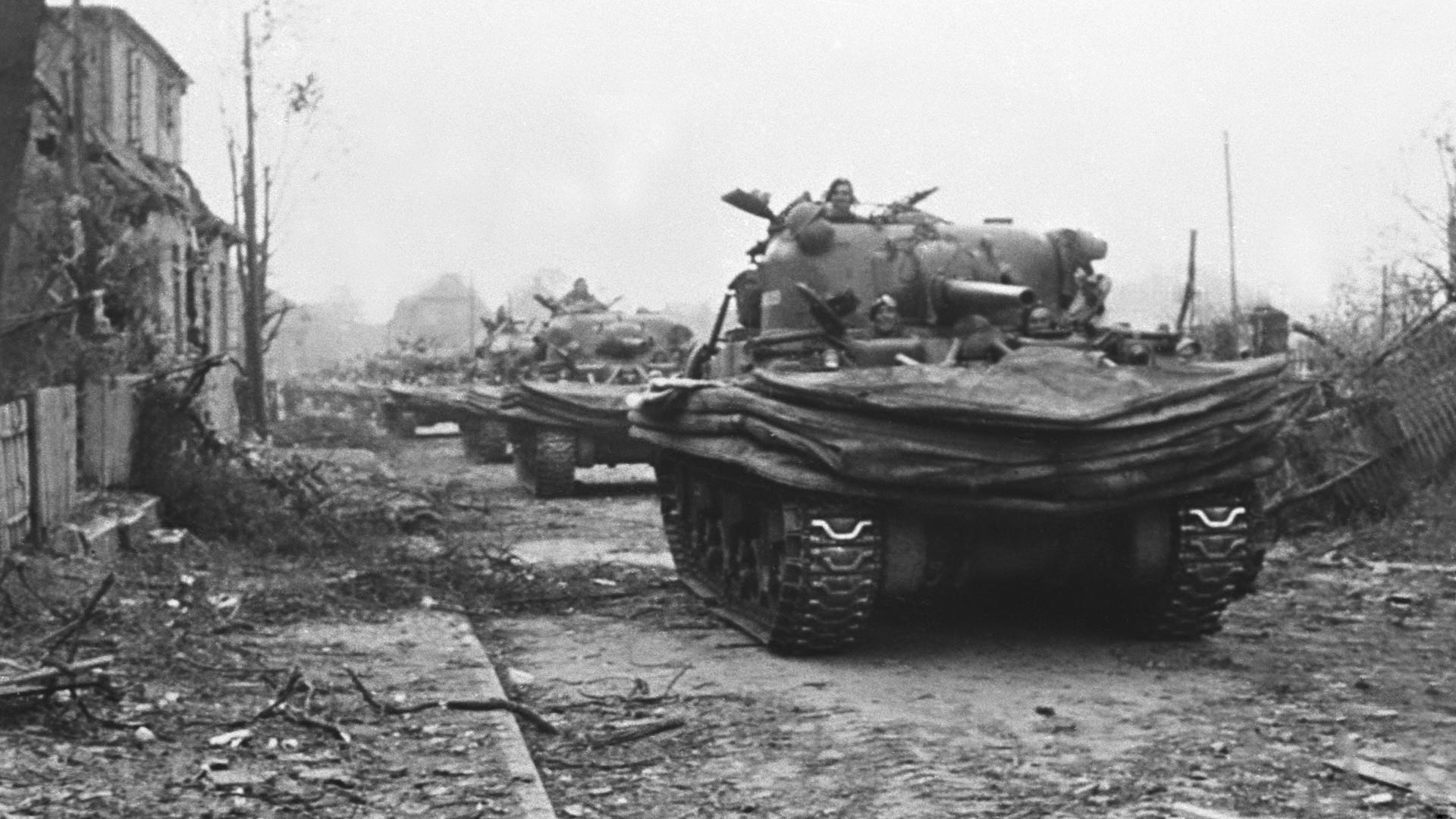 Sherman Duplex Drive of 44 RTR in Launberg having crossed the Rhine (0338-D6)
Sherman Duplex Drive of 44 RTR in Launberg having crossed the Rhine (0338-D6) 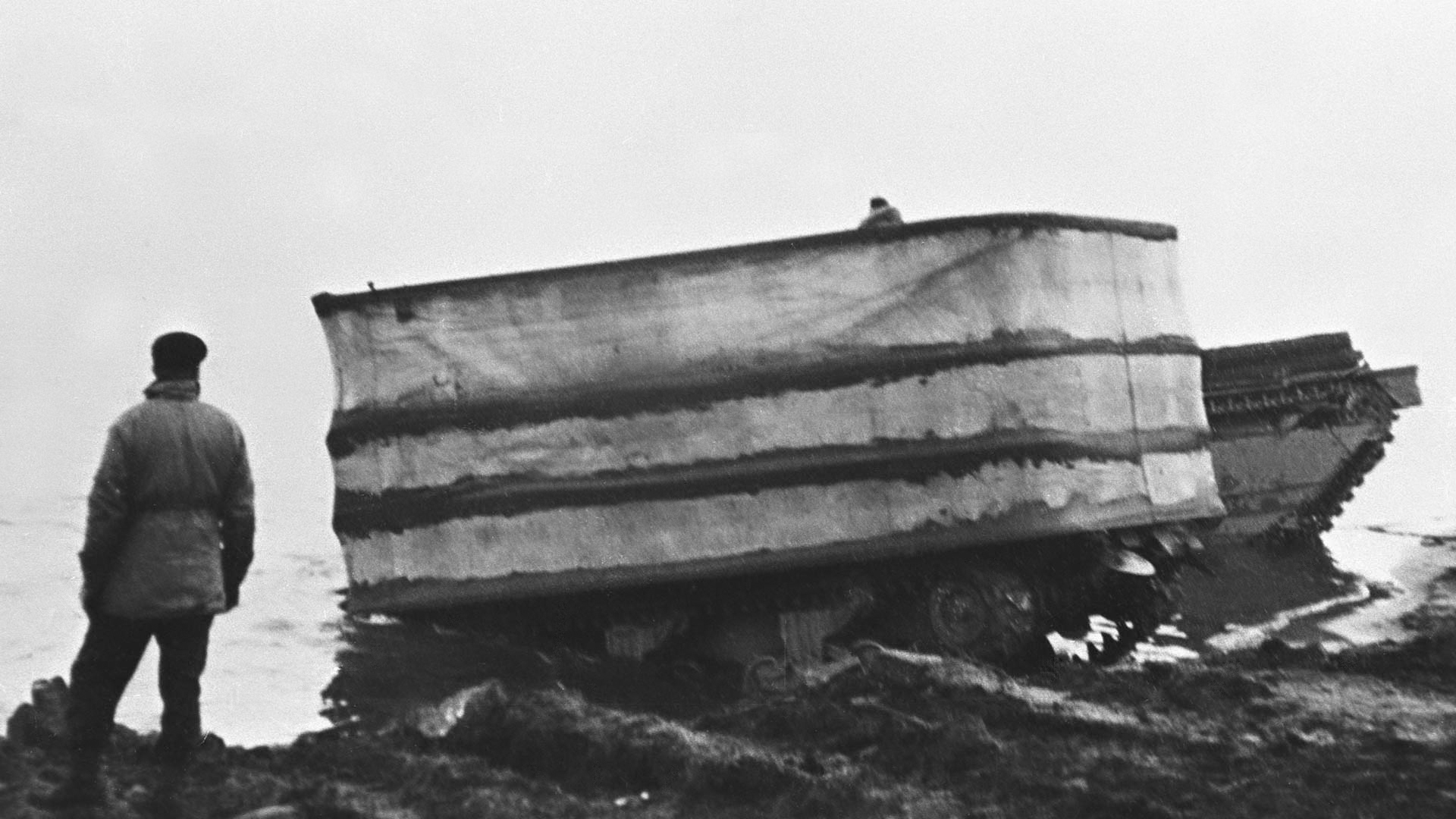 Sherman DD (possibly 44RTR) alongside LVT II (0338-D2)
Sherman DD (possibly 44RTR) alongside LVT II (0338-D2) 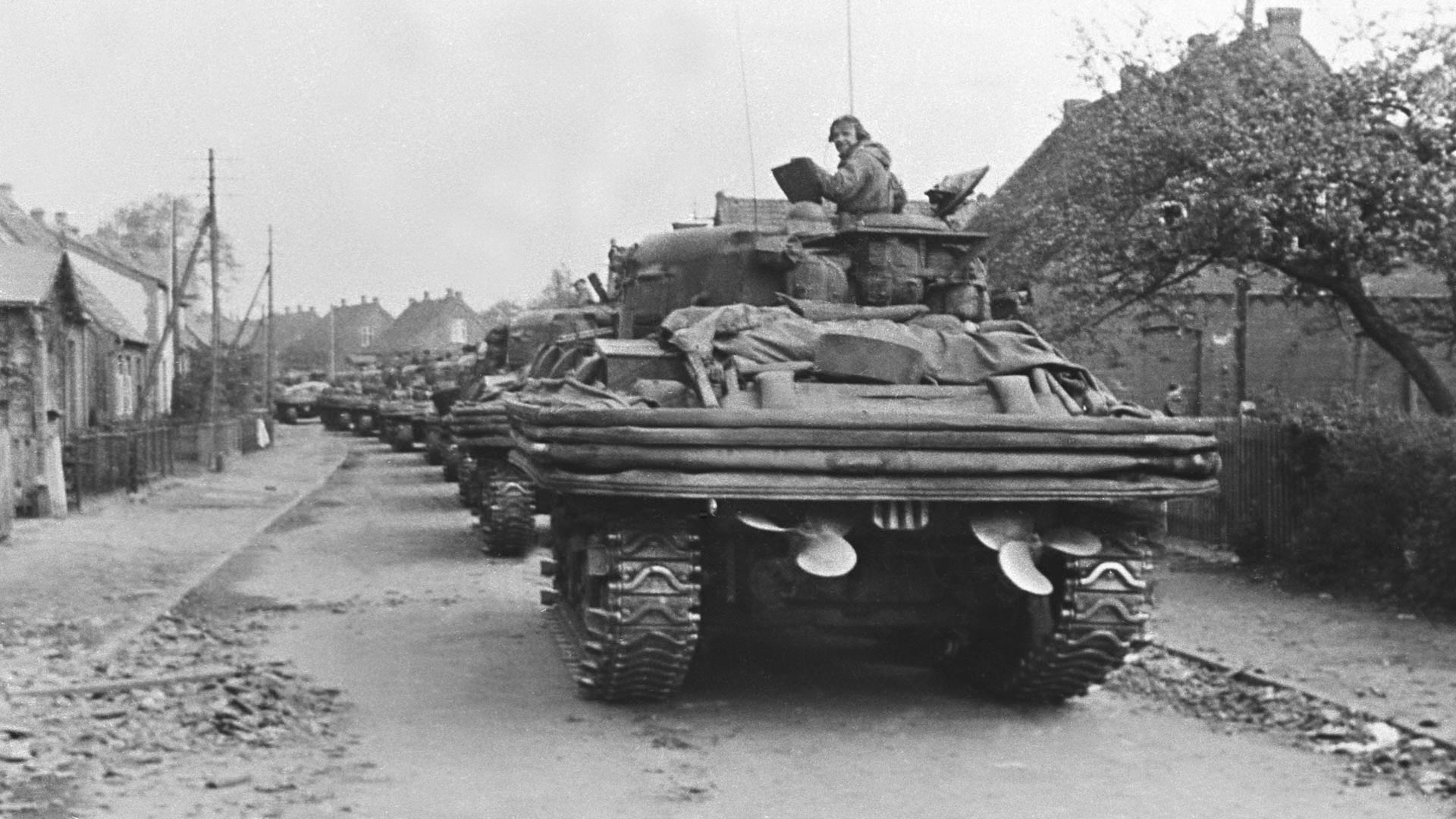 Sherman DD 44 RTR in Launberg after crossing the Rhine (0338-E1)
Sherman DD 44 RTR in Launberg after crossing the Rhine (0338-E1) 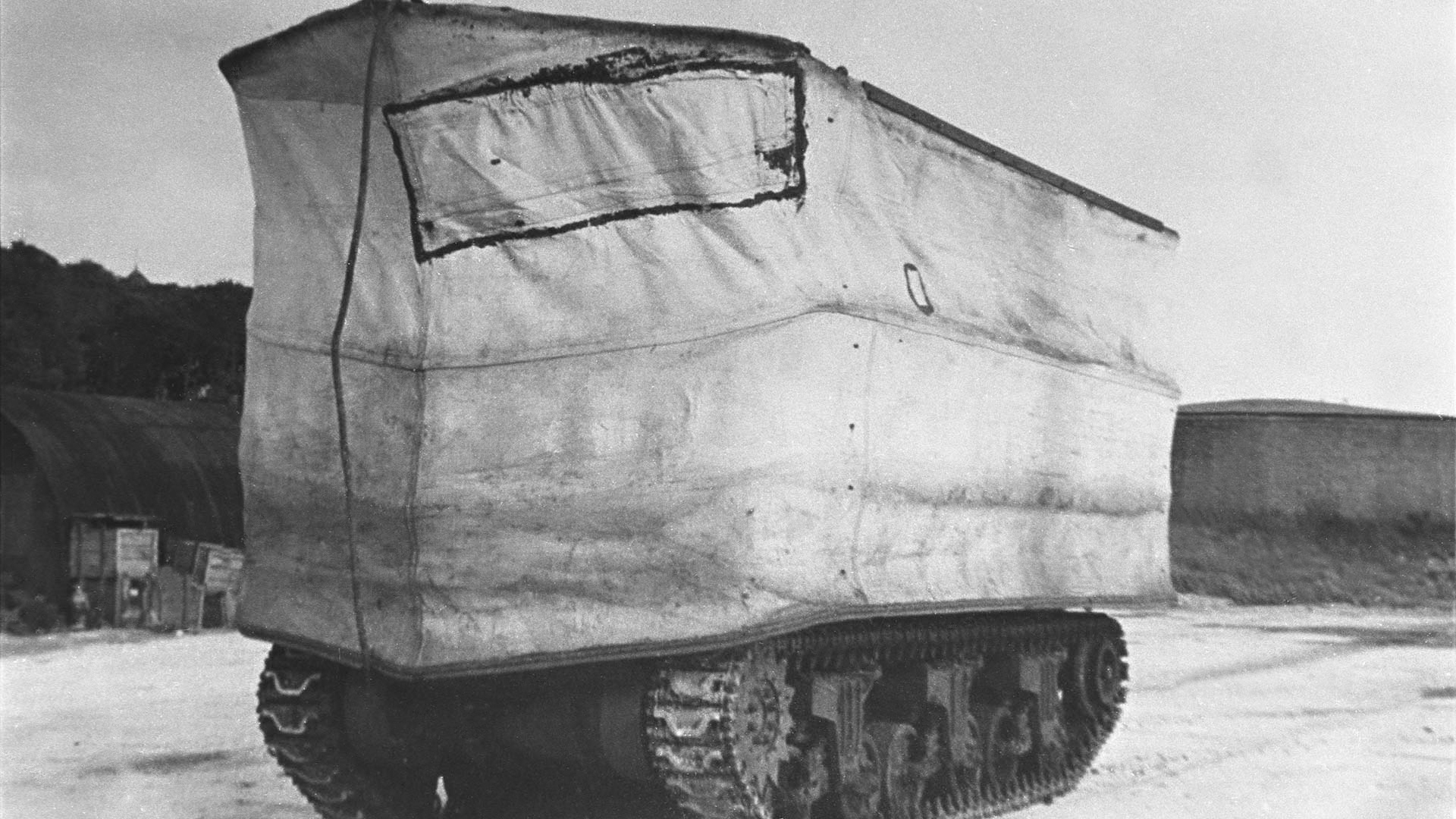 Sherman DD with screen raised (0183-G2)
Sherman DD with screen raised (0183-G2)
Amphibious Adaption. The "swimming" M4A1 or M4A4 Sherman—also known as the Duplex Drive or DD tank—was an amphibious tank used on all five beaches during D-Day. The Sherman tanks were modified to feature a canvas flotation screen for buoyancy with propellers powered by the movement of the tracks—a duplex drive system. They were launched from landing craft up to several miles from the beach, able to support their weight in water, and then the screens were dropped once ashore to provide immediate infantry support.
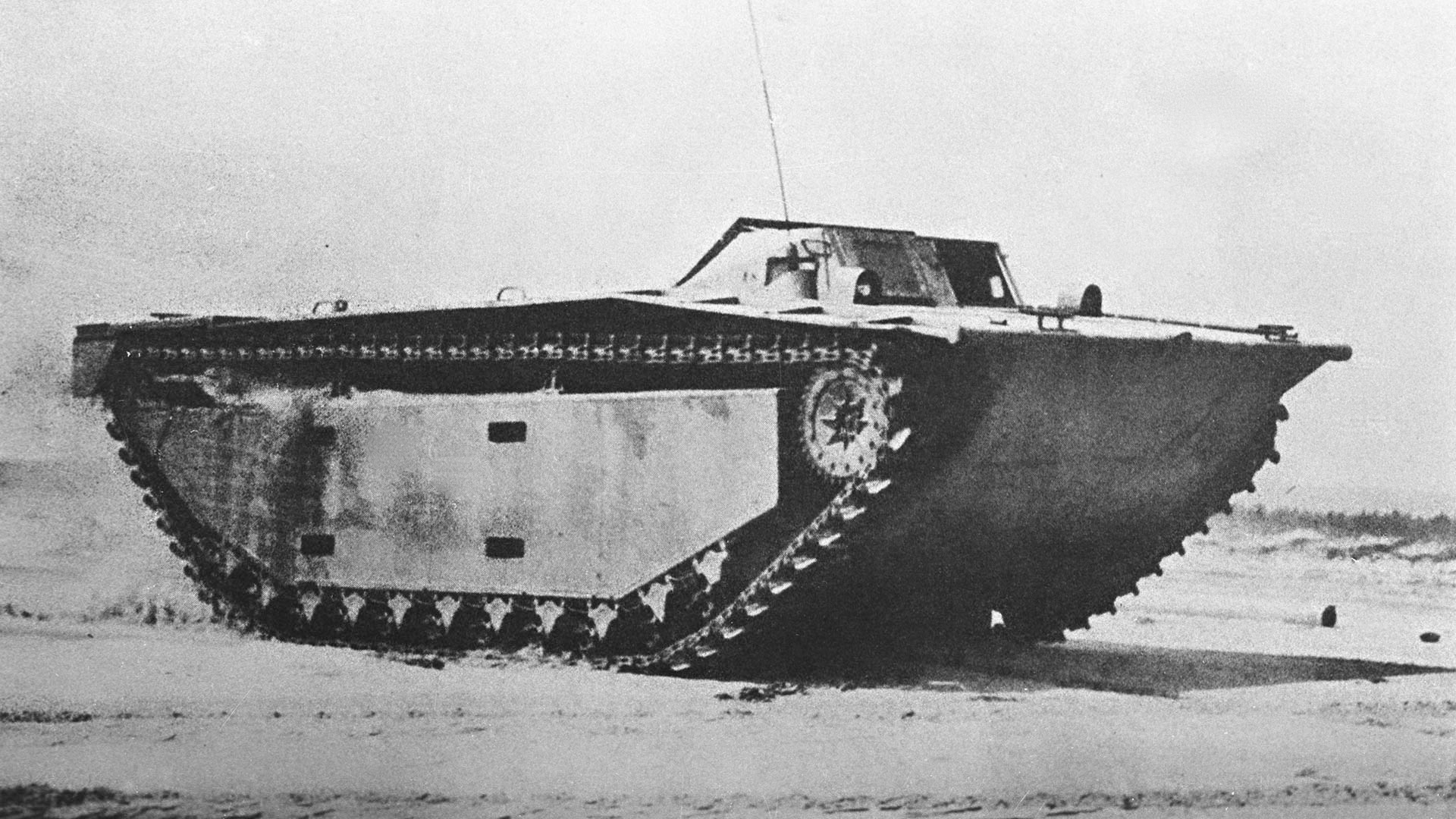 LVT(2) (0030-D3)
LVT(2) (0030-D3) 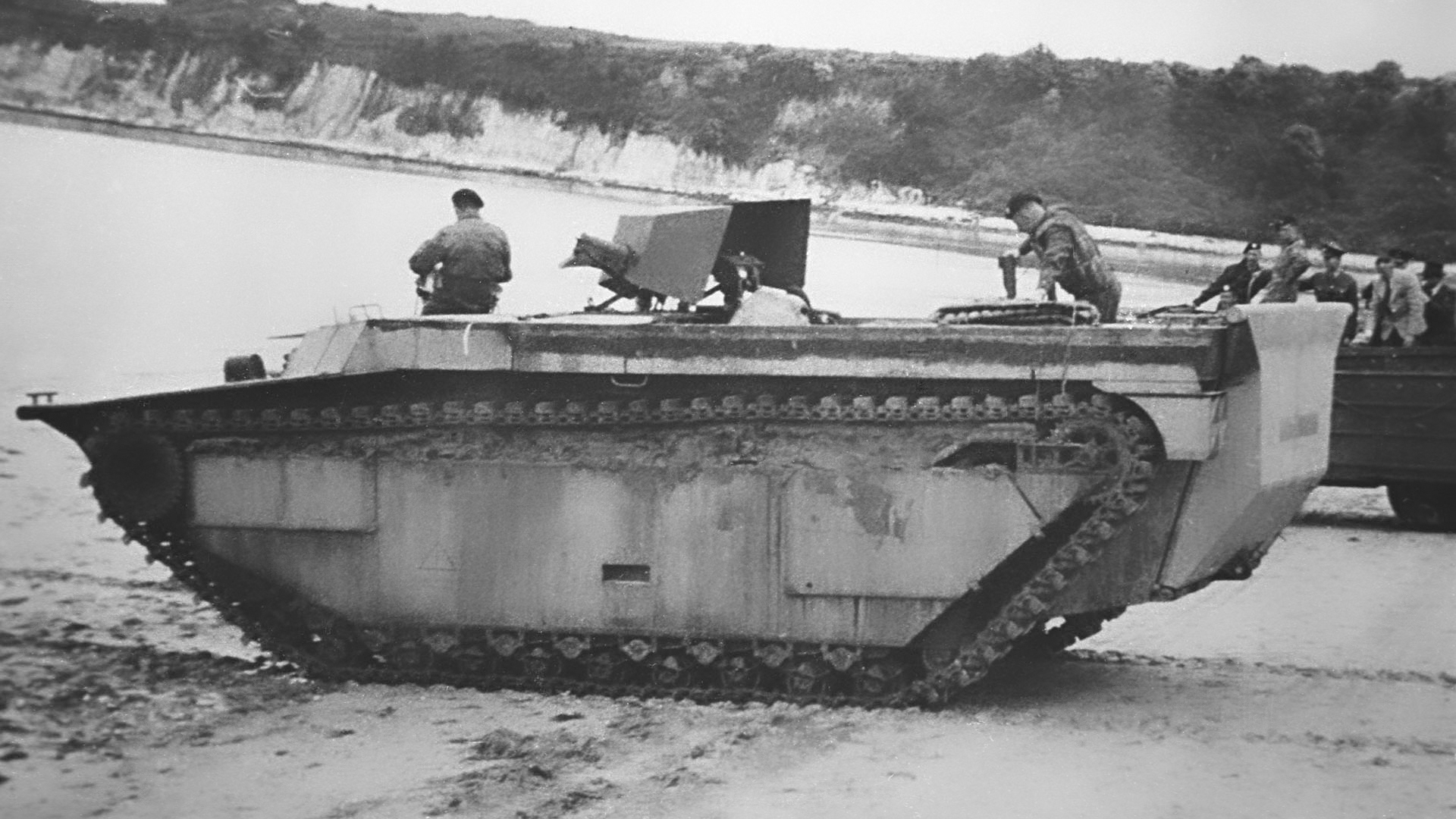 LVT(4) Buffalo with Sea Serpent Flamethrower a Studland Bay (0229-G1)
LVT(4) Buffalo with Sea Serpent Flamethrower a Studland Bay (0229-G1) 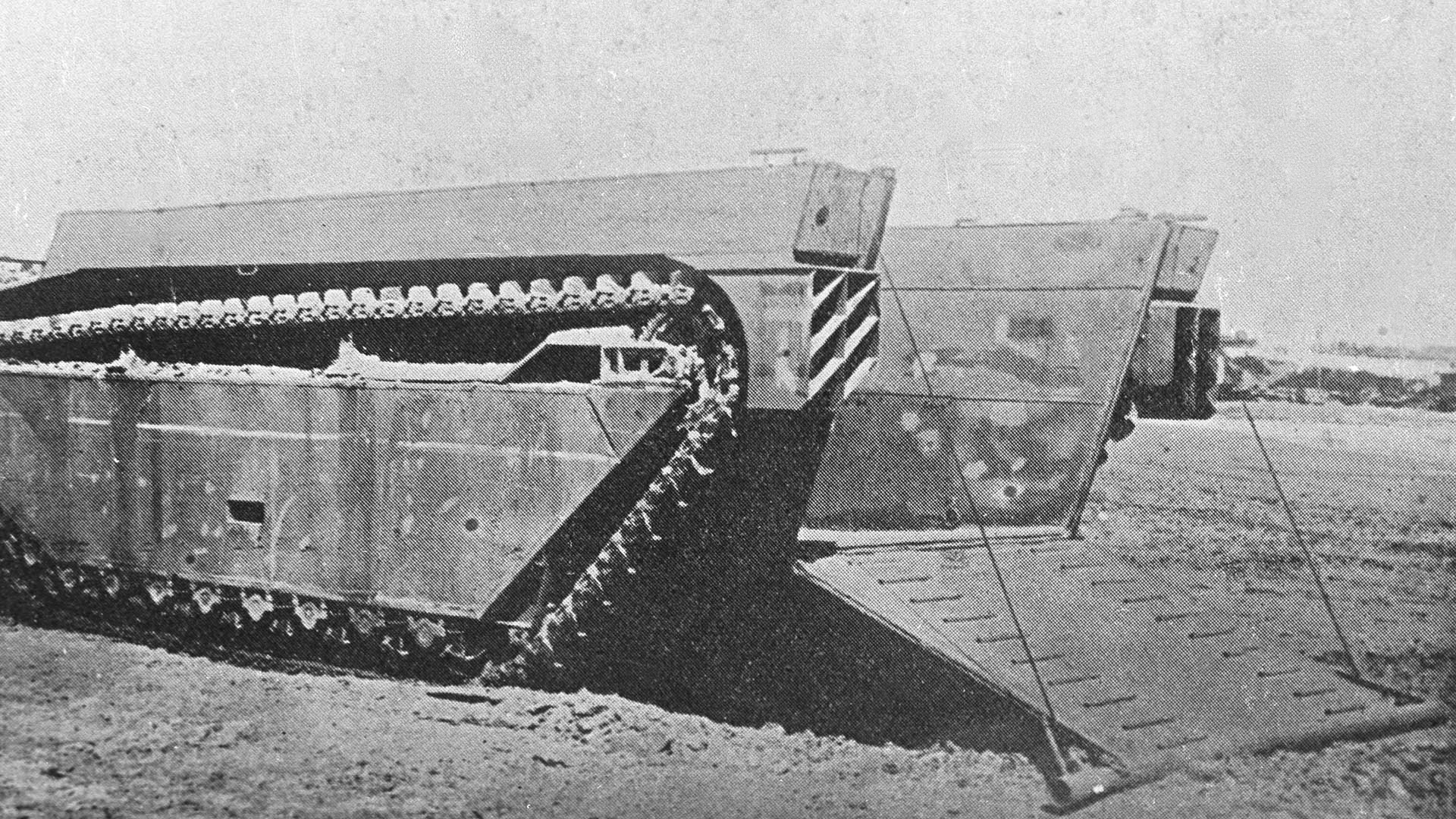 LVT(4) Buffalo Ramp Down (0362-A2)
LVT(4) Buffalo Ramp Down (0362-A2)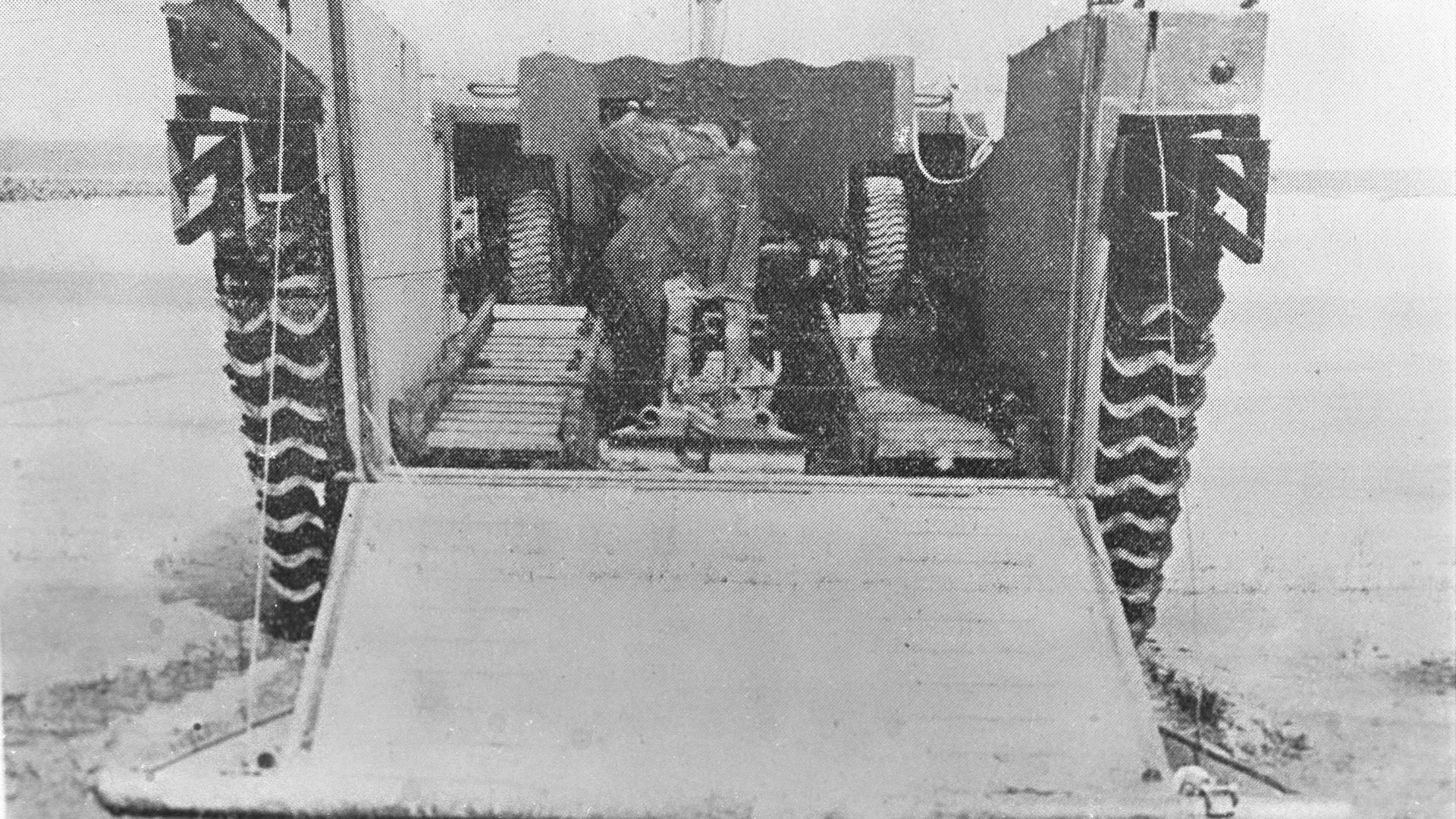 LVT(4) Buffalo with a 6-Pounder Loaded (0362-A3)
LVT(4) Buffalo with a 6-Pounder Loaded (0362-A3)
The Buffalo LVT (Landing Vehicle Tracked). This was a similar amphibious vehicle that also demonstrated an efficient way to transport troops, small vehicles, and supplies.
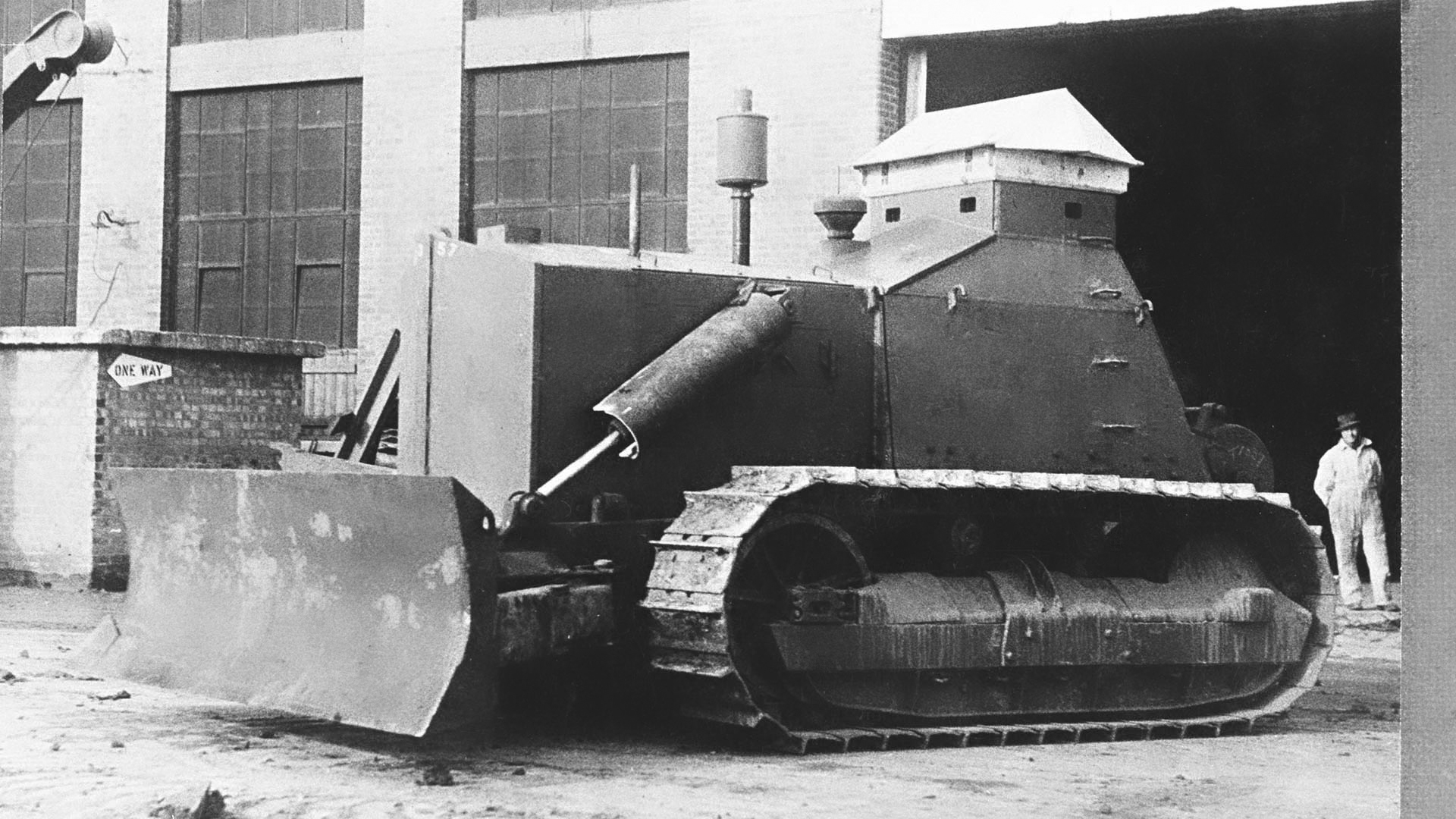 Armored bulldozer, Jack Olding & Co Ltd, Hatfield (6273-C4)
Armored bulldozer, Jack Olding & Co Ltd, Hatfield (6273-C4) 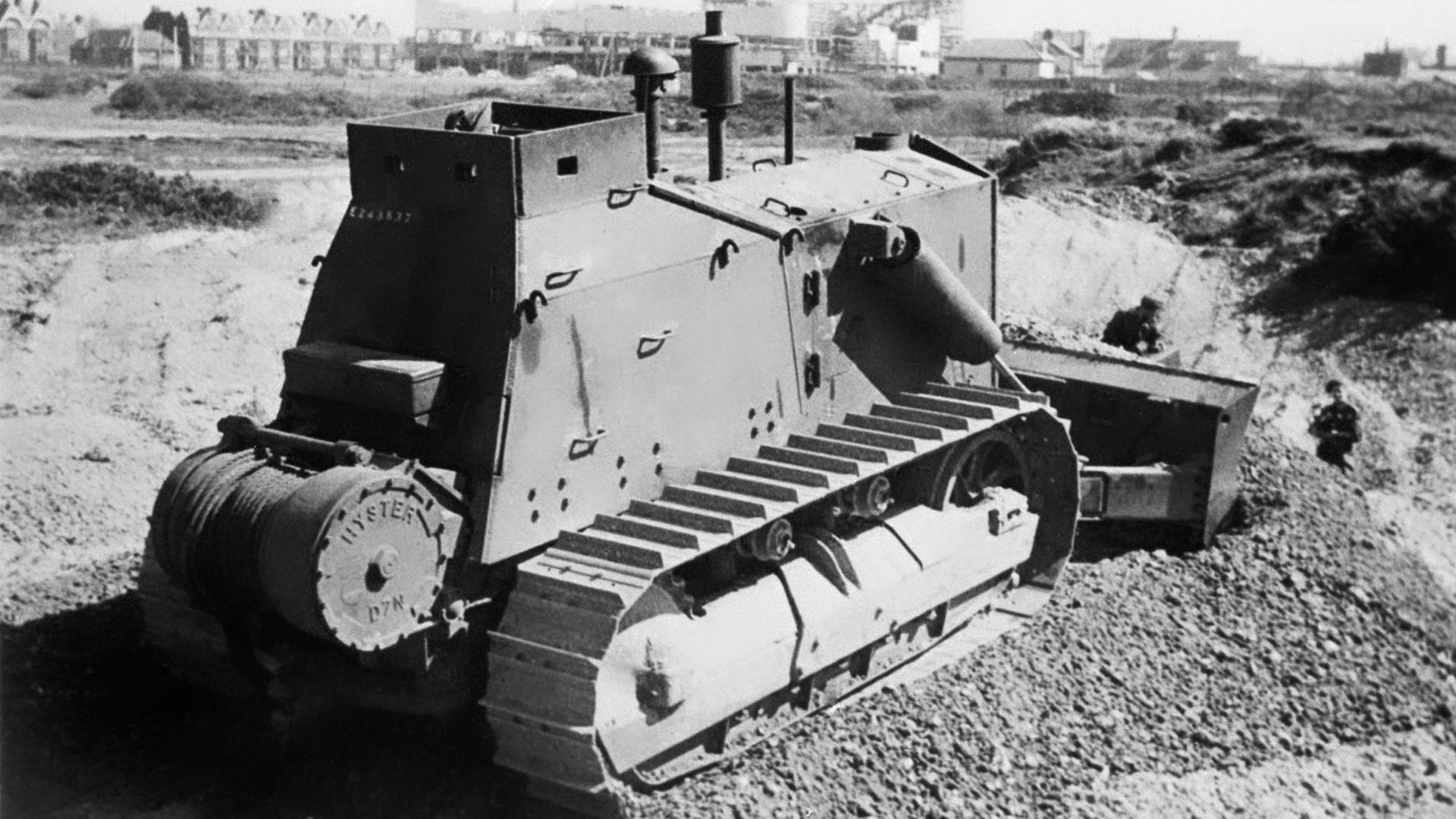 Caterpillar D7 Armoured Bulldozer clearing rubble (2246-B1)
Caterpillar D7 Armoured Bulldozer clearing rubble (2246-B1) Caterpillar D7 armored bulldozer unloading from LCT789 (2246-A6)
Caterpillar D7 armored bulldozer unloading from LCT789 (2246-A6)
Additional Armor. Conventional Caterpillar D7 bulldozers were kitted out with additional metal and armor to protect the driver and the engine.
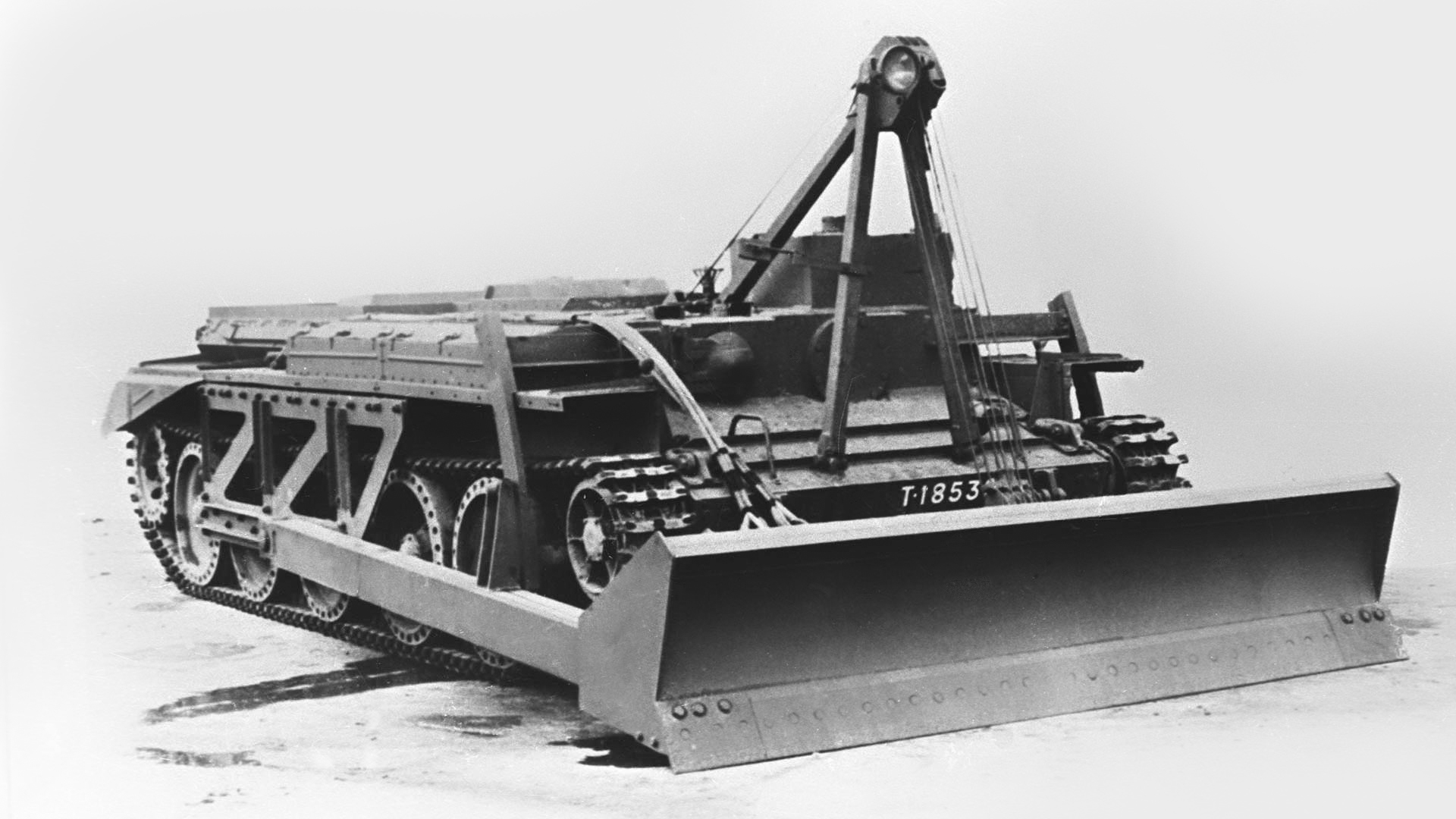 Centaur Dozer (0286-C1)
Centaur Dozer (0286-C1) 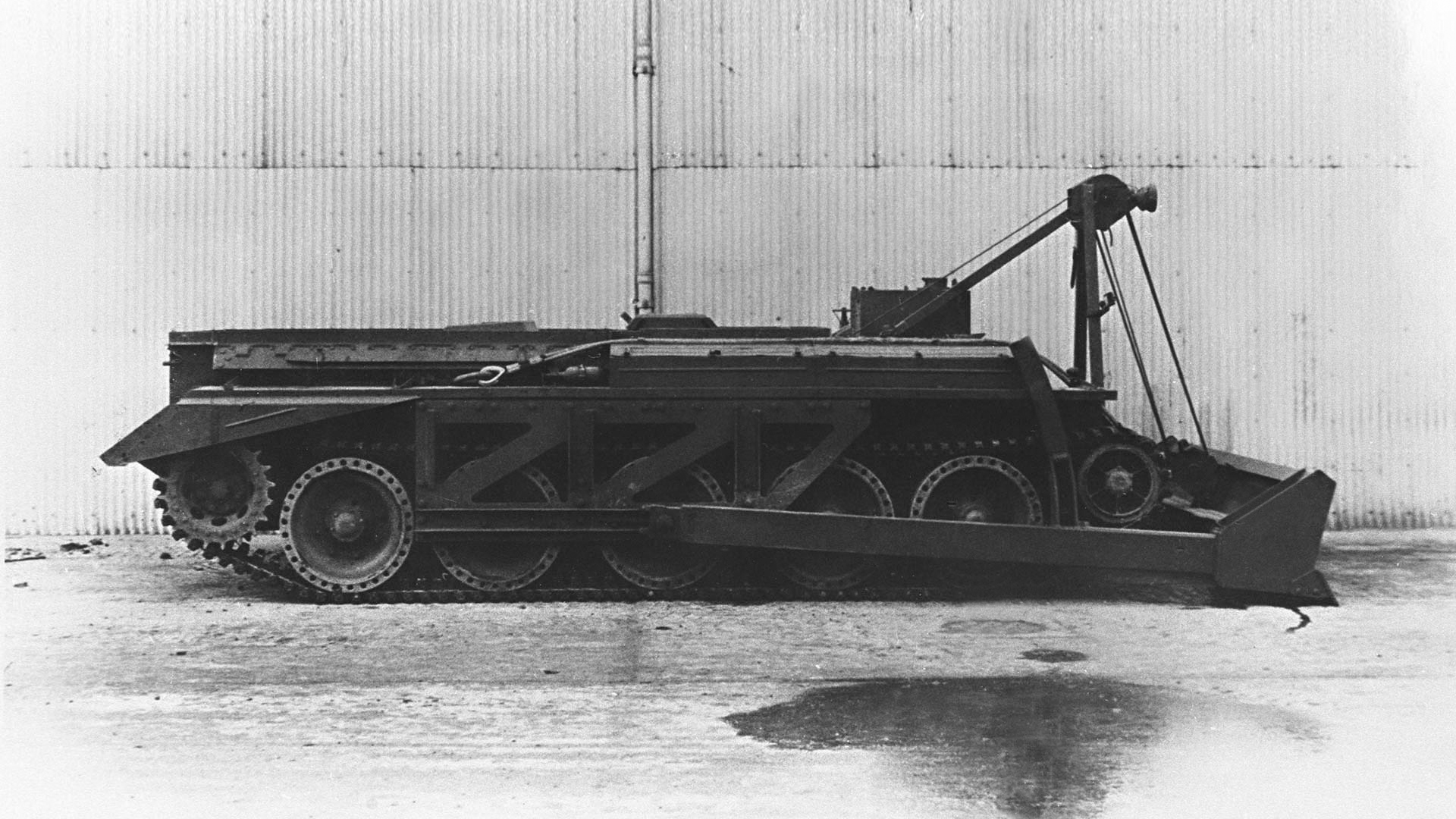 Centaur Dozer (0286-C3)
Centaur Dozer (0286-C3) 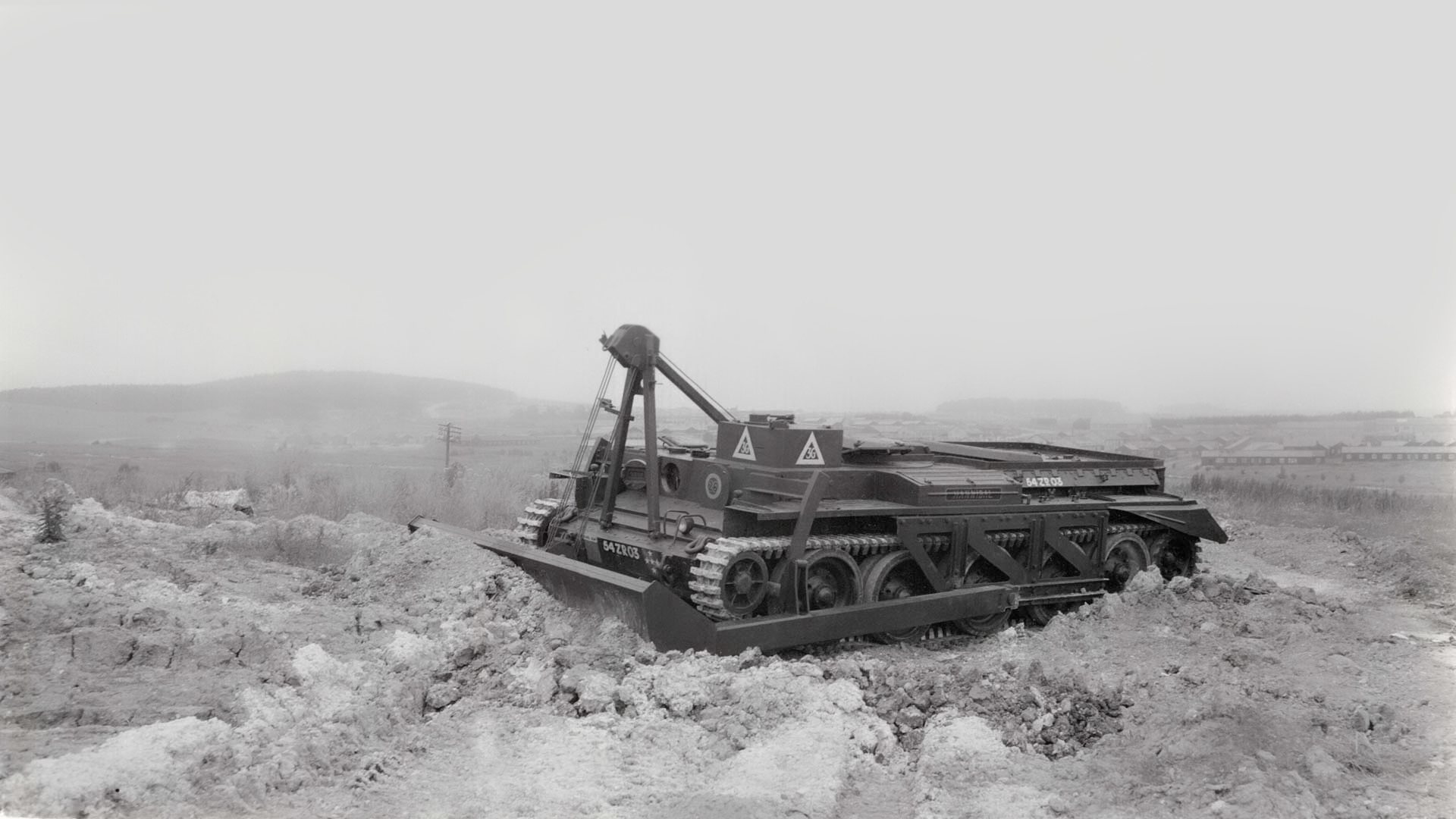 Centaur Dozer Full (centaur-dozer-full)
Centaur Dozer Full (centaur-dozer-full) 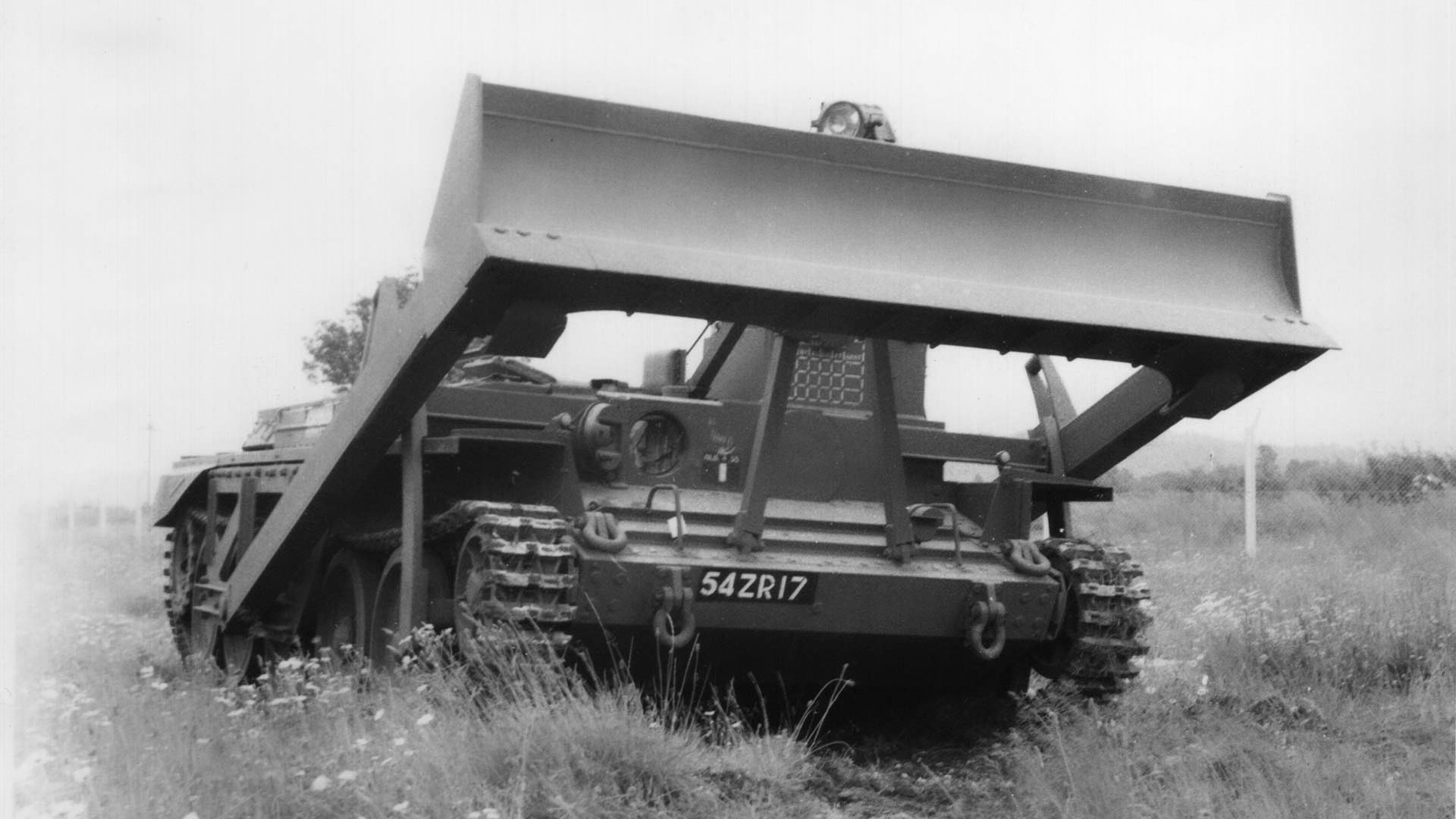 Centaur Dozer Full 2 (centaur-dozer-full-2)
Centaur Dozer Full 2 (centaur-dozer-full-2)
A Step Up from the Rest. The Centaur tank was also stripped apart and remodeled to include a bulldozer blade. The well-armored machine could keep up with tank formations and be used to clear obstacles in German cities in the last weeks of the war.
A Secret Weapon. This M3 Grant-based variation was deliberately named inaccurately to maintain its secrecy. Contrary to its name, it wasn't primarily designed to defend canals. Instead, a specially modified turret featured a powerful carbon-arc searchlight that could illuminate enemy positions during night attacks to dazzle the defenders.
Indirect Artificial Light. While it may not have seen action on D-Day, it was later used to defend the captured bridge across the river Rhine at Remagen from German attacks.
The High Cost of Victory
Despite the meticulous planning and extensive preparations, not everything went smoothly on D-Day. Many men and tanks were lost before they even reached the shore or soon after, and the initial assault saw significant casualties and equipment losses.
For instance, at Omaha Beach, only two of the 29 Duplex Drive tanks launched into the sea made it to shore, highlighting the severe challenges faced during the landings. Troops across various beaches encountered fierce resistance and harsh conditions, while airborne units tasked with securing key inland positions also endured heavy losses. The loss of life was staggering:
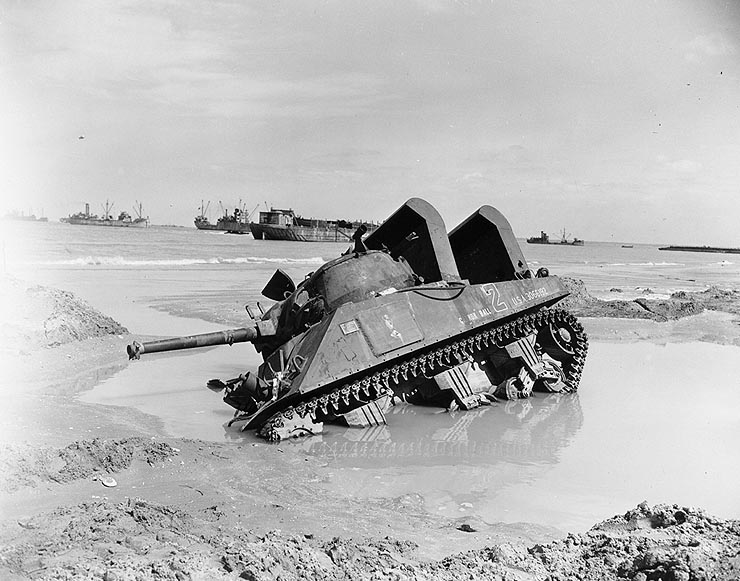 Mired M4 Sherman tank, June 12, 1944
Mired M4 Sherman tank, June 12, 1944 - U.S. forces at Omaha Beach suffered approximately 2,000 casualties out of 34,250 deployed.
- Canadian forces at Juno Beach faced 1,204 casualties out of 21,400 soldiers.
- The 101st Airborne Division suffered 1,240 casualties.
- The 82nd Airborne Division counted 1,259 casualties.
- The 6th British Airborne Division reported 1,500 casualties.
- A total of 2,501 Americans, 2,700 British, and 1,074 Canadians were killed on June 6, 1944.
Many more troops from other nations (some in exile) participated in the operation and endured losses, including France, Australia, Poland, Czechoslovakia, Greece, the Netherlands, New Zealand, Norway, South Africa, and Southern Rhodesia—to name but a few.
These sobering figures underscore the high cost of the operation, which ultimately succeeded due to the extraordinary bravery and sacrifice of the Allied forces.
Remembering D-Day: Innovation, Sacrifice, and Valor
As we reflect on the remarkable innovations and the tremendous sacrifices of D-Day, it is crucial to honor the bravery of those who made the ultimate sacrifice. The success of the Allied invasion hinged not only on strategic deception and meticulous planning but also on the ingenuity of technological advancements like Hobart's Funnies.
Throughout this month, join us in commemorating the 80th anniversary of this historic event with various D-Day activities, including historical live streams, a special Battle Pass Season, a brand-new PvE game mode, and exclusive content that celebrates the heroism of that pivotal day.
D-Day: Allied Landings in Normandy
Watch our mini-documentary, created for the 75th D-Day anniversary, featuring more footage of the events and vehicles that shaped June 6, 1944.
Automatically translated subtitles are available through the Settings menu.
We hope you enjoyed your history lesson, Commanders!
Visit the Command Center to learn more about the D-Day events in June. Earn D-Day Tokens and maximize your rewards as we commemorate this historic event.
Sources
ExpandImages are courtesy of the The Tank Museum Ltd., Bovington, U.K., except for the following:
- Percy Hobart: This image is in the public domain (United Kingdom Government)
- Mired M4 Sherman tank: This image is in the public domain (Naval History and Heritage Command)
Additional Resources:

